Scrapbooking Transforms Memories Into Art
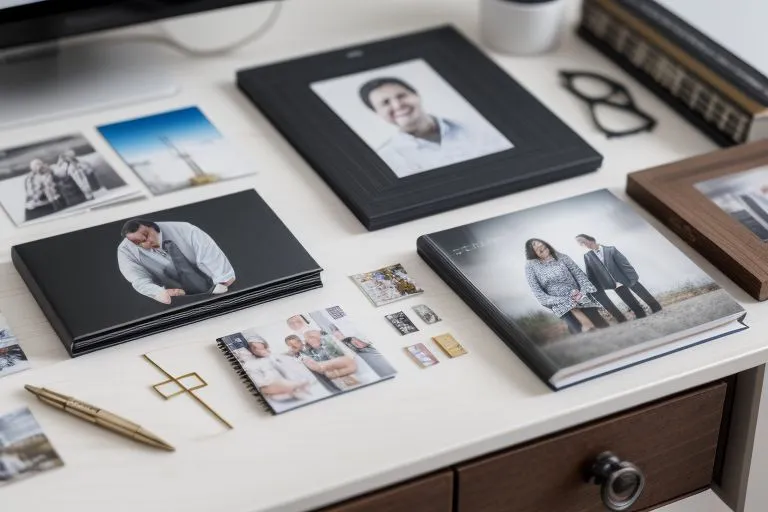
With each delicate turn of a page, memories unfold like a masterpiece, telling stories of love, laughter, and adventure.
Preserving memories is essential, and scrapbooking offers a unique and creative way to do so by transforming memories into art that lasts a lifetime. By incorporating memory preservation techniques and craft supplies, we can relive and share our most precious moments with family and friends.
One of the primary benefits of scrapbooking is that it provides a tangible representation of our memories, allowing us to physically hold and interact with them.
Unlike traditional photo albums, scrapbooking enables an emotional connection to the past, making it a cherished activity for many. The art of memory preservation involves creatively using craft supplies, such as photo albums, paper crafting, and embellishments, to beautifully document cherished moments through journaling.
What Is Scrapbooking All About
Through the fusion of nostalgia and artistry, a unique narrative unfolds, allowing individuals to immortalize their most precious experiences.
Scrapbooking is an art form that allows individuals to hold onto memories and emotions, providing a timeless way to relive happy moments and share personal stories.
In its essence, this creative outlet transcends mere photo arrangement, incorporating intricate diecutting designs, carefully selecting adhesives to secure memories, and embellishing with playful stickers.
As a multifaceted hobby, scrapbooking enables individuals to express themselves through art, design, and imagination, using materials like textured cardstock and colorful washi tape to bring their vision to life.
By doing so, scrapbooking fosters a sense of connection to the past, while also providing a creative outlet for expression using various materials such as diecutting, adhesives, stickers, decorative scissors, cardstock, and washi tape.
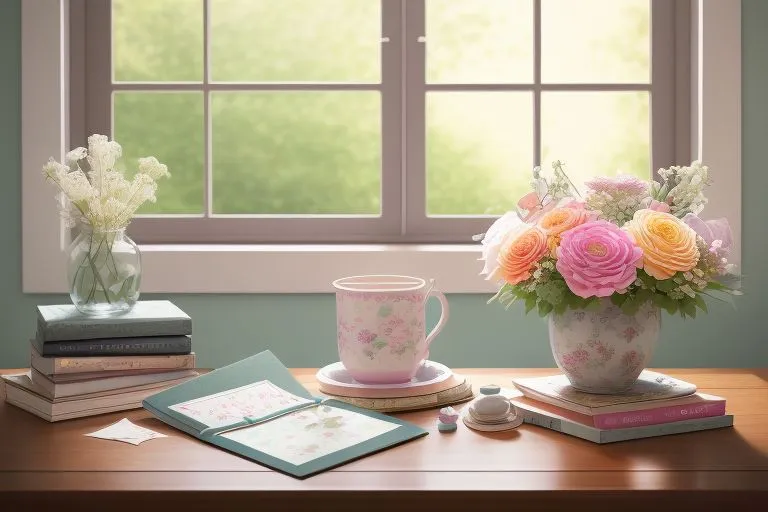
Essential Memory Preservation Craft Supplies
As we navigate the complexities of life, it’s the memories we hold dear that provide a sense of continuity and connection to our past, present, and future.
The importance of preserving memories cannot be overstated. Memories matter in our lives because they help shape our identities, provide comfort, and create a sense of belonging.
The emotional value of holding onto memories is immeasurable, as they bring joy, solace, and a sense of connection to our past.
When it comes to preserving memories, the quality of craft supplies used can make all the difference.
Using acid-free materials, such as themed pages, is crucial, as they prevent memories from deteriorating over time. Archival-quality supplies, including stamps, ink pads, punches, and acid-free materials used in creative layouts, themed pages, and display of memorabilia, ensure that memories remain intact for generations to come.
Creating Themed Pages And Layouts
In the world of scrapbooking, the art of storytelling takes center stage, and using archival quality materials is essential to preserving cherished memories in a unique and visually stunning way.
Importance of Visual Storytelling in Memory Preservation.
Visual storytelling is essential in memory preservation, as it enables you to evoke emotions and memories through the use of mixed media elements, transporting you back to a specific moment in time. Themed pages and layouts enhance storytelling in scrapbooking by providing a cohesive and engaging design, making it easier to relive cherished moments. By incorporating archival quality, acid-free materials, and digital techniques into heritage albums, scrapbookers can create lasting mixed media masterpieces that tell memorable stories at crop parties.
Why Choose Archival Quality Materials
In the world of creative expression, the subtle art of layering memories and emotions onto a single canvas can be a powerful way to preserve our most treasured moments.
When it comes to creative projects, the materials used can make all the difference in preserving memories and artwork for generations to come. Archival quality materials are specifically designed to ensure the longevity of your projects, and using them can have a significant impact on the overall quality and durability of your work.
In contrast, using low-quality materials can lead to degradation, discoloration, and even complete destruction of your project over time.
Defining Archival Quality Materials
Vintage elements and ephemera are only as good as the materials that hold them together, which is why archival quality materials are made to meet specific standards for collage, layering, and color coordination, allowing for rich storytelling with enduring vintage charm.
Archival Quality Materials
- Archival quality materials are designed to last for generations, with a minimum lifespan of 100 years.
- Using low-quality materials can lead to a 50% decrease in the lifespan of a project, resulting in degradation, discoloration, and destruction.
- Archival quality materials meet specific standards, including acid-free, lignin-free, and pH-neutral, to ensure the longevity of artwork and memories.
- Professional artists and conservators recommend using archival quality materials to preserve the integrity and value of creative projects.
Exploring Creative Expression Through Embellishments
As we weave family history into our art, we discover a unique language that speaks directly to the soul.
Introduction to Embellishments
Decorative elements added to a piece of art, craft, or design can elevate its aesthetic appeal and convey meaning, allowing for a deeper level of creative expression.
Throughout history, ornate details have been used in various forms of art and craft, from intricate jewelry designs to ornate manuscript illuminations, revealing the significance of embellishments in storytelling.
In the context of creative expression, these decorative elements play a significant role in conveying emotions, personality traits, and ideas, making each piece a personalized gift that tells a story. By combining family history, creative expression, personalized gifts, album covers, page protectors, and a paper trimmer, you can unlock a unique and personalized style that tells a story beyond the basics.
How To Start Digital Scrapbooking
Capturing life’s precious moments has never been more convenient, creative, and eco-friendly than with digital scrapbooking, a modern approach to preserving memories that’s revolutionizing the way we tell our stories.
Why Digital Scrapbooking?
Digital scrapbooking offers numerous benefits over traditional paper crafting.
Not only is it more convenient, portable, and space-saving, but it’s also an environmentally friendly option that reduces waste.
With digital scrapbooking, you can easily skip the hassle of corner rounders and heat tools, and instead, work on your projects from any location, at any time, with just a few clicks.
One of the greatest advantages of digital scrapbooking is the elimination of physical storage needs, making it an ideal option for those with limited space. This modern approach also reduces waste, as you can easily edit and revise your designs without generating excess corner rounders, embossing, heat tools, ribbon, eyelets, or brads.
Benefits of Digital Scrapbooking
- Digital scrapbooking is more convenient, portable, and space-saving compared to traditional paper crafting.
- It eliminates the need for physical storage, making it ideal for those with limited space.
- Digital scrapbooking reduces waste by allowing easy editing and revision of designs without generating excess materials.
- It allows for greater flexibility, enabling users to work on projects from any location, at any time, with just a few clicks.
Storytelling With Photos And Journaling
Memories frozen in time, old photographs have a profound ability to transport us back to a moment, evoking emotions and stories that were previously hidden.
Storytelling with photos and journaling is a powerful way to unlock these memories and emotions, and preserve them for generations to come.
In today’s digital age, visual storytelling has become more important than ever, with chipboard-inlaid photographs evoking emotions and memories that words alone cannot convey.
Journaling complements photography in storytelling, allowing us to capture the story behind the vellum-textured photo, and provide context to the memories we’re preserving. By incorporating chipboard embellishments, rubons, and vellum accents onto distressed background papers featuring beautiful border designs, we can create a rich tapestry of memories that tell our story in a unique and personal way.
Joining Online Scrapbooking Communities
Capturing life’s moments through scrapbooking is a therapeutic escape, allowing crafty individuals to unleash their creativity and tell their stories. By joining an online scrapbooking community, they can elevate their skills, gain inspiration, and connect with like-minded individuals who share their passion for preserving memories with sequins and glitter.
Diverse perspectives and ideas are at the heart of online scrapbooking communities.
These platforms bring together individuals from different backgrounds and skill levels, fostering a rich exchange of ideas and techniques.
Whether you’re a seasoned scrapbooker or just starting out, you’ll find inspiration in the unique approaches and experiences shared by community members, who often experiment with photo corners and dimensional elements to add texture to their projects.
Being part of a community can help you stay motivated and accountable.
| Benefits of Online Scrapbooking Communities | Effects on Scrapbookers |
|---|---|
| Diverse perspectives and ideas | Staying motivated and accountable |
| Elevating skills and gaining inspiration | Unleashing creativity and telling stories |
| Connecting with like-minded individuals | Fostering a rich exchange of ideas and techniques |
Upcycling Crafts Transform Trash Into Treasures

As we navigate the complexities of modern life, it’s heartening to know that discarded materials can be transformed into unique masterpieces, reducing waste and conserving natural resources.
Ecofriendly crafting offers a creative outlet that’s not only good for the planet but also showcases your personality, allowing you to stand out from the crowd.
Through repurposing materials, you’ll reduce your carbon footprint and contribute to a more sustainable future, where trash is no longer destined for landfills.
DIY projects empower you to unleash your creativity, breathing new life into discarded items and turning them into functional and beautiful pieces that tell a story. The world of art and crafting has been revolutionized by innovative concepts like repurposing, DIY projects, sustainable art, ecofriendly crafting, and creative recycling.
What Is Upcycling In Crafts
By embracing the art of creative reinvention, we can breathe new life into discarded materials and unlock a world of innovative possibilities.
Upcycling, a term coined in the 1990s, is the process of transforming unwanted materials into new, useful, and often creative products of greater value than the original.
This process differs from recycling, which involves breaking down materials into their raw form and reusing them.
The roots of upcycling can be traced back to the early 20th century, when resource scarcity and economic instability made it necessary to find innovative ways to repurpose and reuse trash to treasure.
Today, upcycling has become a powerful tool for promoting sustainability and reducing waste.
In the world of crafts, creatives are using reclaimed materials to produce unique and imaginative pieces that not only reduce waste but also tell a story. By transforming discarded items into unique pieces, artists are turning trash to treasure through reclaimed materials, vintage reimagining, found object art, and ultimately achieving waste reduction.

Understanding The Repurposing Movement
Why Repurposing Matters
As we navigate the complexities of modern living, repurposing takes center stage as a powerful antidote to environmental degradation. By embracing handmade decor and environmentally conscious practices, we can significantly reduce waste, conserve natural resources, and promote sustainable lifestyles.
Repurposing helps preserve cultural heritage and fosters creative expression, allowing individuals to showcase their innovative reuse skills.
In the face of ecological catastrophe, repurposing offers a glimmer of hope.
It’s an opportunity to get creative, think outside the box, and breathe new life into salvaged goods transformation. By embracing handmade decor, environmentally conscious habits, innovative reuse, and the transformation of salvaged goods into green crafting, we can create a more sustainable future.
- According to the United Nations, the world generates over 2 billion tons of municipal solid waste annually, with at least 33% not being managed in an environmentally safe manner, highlighting the need for repurposing and waste reduction.
- A study by the Environmental Protection Agency (EPA) found that recycling and composting in the United States saved 117 million metric tons of carbon dioxide equivalent emissions in 2019, equivalent to taking 23 million cars off the road for a year.
- Repurposing and upcycling can also have a significant economic impact, with the global market for second-hand and refurbished products projected to reach $143 billion by 2025, according to a report by ResearchAndMarkets. com.
- In addition, a survey by the online marketplace eBay found that 70% of consumers consider the environmental impact of their purchasing decisions, and 62% are more likely to buy from a brand that uses recycled or sustainable materials.
Ecofriendly Crafting For Beginners
In the quest for creative expression, a new wave of crafters is embracing a junk makeover approach that harmoniously merges artistry with environmental responsibility.
Traditional crafting materials can have a significant environmental impact, from the production and distribution of synthetic resources to the waste generated by non-biodegradable materials. This raises important questions about the true cost of our creative pursuits.
In contrast, ecofriendly crafting offers a resourceful creativity approach that not only reduces waste but also promotes a healthier planet and personal well-being.
By choosing sustainable materials and practices, crafters can minimize their ecological footprint while maximizing their creative output.
As we explore the realm of thrift store revamps, we’ll uncover the benefits of sustainable crafting for the planet and personal well-being. From identifying ecofriendly materials to transforming trash into treasure, our junk makeover showcases resourceful creativity through thrift store revamps and second-life creations, ultimately yielding ecochic designs.
Transforming Trash Into Treasure
In the midst of our consumption-driven society, a quiet revolution is emerging, where creative minds are seeking innovative ways to breathe new life into discarded materials, effectively redefining the concept of waste.
In recent years, the concept of transforming trash into treasure has gained popularity as a creative way to reduce waste and promote sustainable living.
The growing concern about waste management and environmental sustainability has led to a renewed focus on reducing, reusing, and recycling waste.
This creative approach not only helps to mitigate the environmental impacts of waste disposal but also unlocks the potential of turning waste into valuable resources.
One of the most significant benefits of transforming trash is the conservation of natural resources. By reusing and recycling materials, we can reduce the demand for raw materials and preserve natural resources for future generations, such as sustainable home decor that gives old materials a new purpose. This process reduces greenhouse gas emissions while promoting innovative concepts like upcycled fashion, reinvented furniture, adaptive reuse, sustainable home decor, and creative reuse centers.
Transforming Trash into Treasure
- The global recycling industry is projected to reach $377 billion by 2024, up from $247 billion in 2017, according to a report by Grand View Research.
- Upcycling can reduce greenhouse gas emissions by up to 50% compared to producing new products from raw materials, according to a study by the University of California, Los Angeles.
- In the United States alone, it is estimated that upcycling and recycling can create over 5 million jobs, generating $117 billion in economic activity each year, according to the Environmental Protection Agency.
- The average American generates about 4 pounds of trash per day, with only about 34% being recycled or composted, according to the United States Environmental Protection Agency.
Creative Recycling Project Ideas
In the face of environmental degradation, innovative thinkers are turning trash into treasure, breathing new life into discarded materials and redefining the concept of waste.
The current state of waste management is dire, with millions of tons of waste ending up in landfills and oceans, causing irreparable harm to the environment.
The rise of creative recycling has provided a glimmer of hope, offering an innovative solution to this pressing problem.
Conservation of natural resources is a significant benefit of creative recycling, as it reduces the need for extracting and processing raw materials.
By upcycling old pallet projects into functional items, individuals can reduce landfill waste and pollution, promoting sustainable living and eco-friendliness. Creative recycling fosters creative skills and self-expression, allowing individuals to think outside the box and repurpose discarded materials into unique tin can crafts, artisan creations that can be showcased in a marketplace, used in jewelry making, or even transformed into functional pallet projects and eclectic bottle cap art.
Reclaimed Materials In Artistry
As the world grapples with the consequences of consumerism, a quiet revolution is unfolding in the art world, where creatives are breathing new life into discarded treasures to craft extraordinary fabric scrap creations.
In an era where environmental sustainability is paramount, traditional art supplies are being replaced by repurposed materials, significantly reducing waste and pollution.
The environmental impact of art supplies cannot be overstated, with an estimated 10% of global pollution attributed to the art industry.
The history of upcycling in art and craft dates back to the 19th century, where resourceful artists would transform discarded materials into functional old book crafts.
Today, this practice has evolved into a powerful medium for creative expression and environmental activism. The benefits of using reclaimed materials in art are multifaceted, from reducing waste and conserving natural resources to sparking imagination and creativity, as seen in the versatility of fabric scrap creations, old book crafts, mason jar ideas, bicycle parts art, and wine cork projects.
- An estimated 10% of global pollution is attributed to the art industry.
- The history of upcycling in art and craft dates back to the 19th century.
- Using reclaimed materials in art reduces waste and conserves natural resources.
- The practice of upcycling sparks imagination and creativity in artists.
Sustainable Art Techniques Explained
As creatives, we have a unique opportunity to make a positive impact on the environment through the art we produce, and sustainable art techniques are leading the charge.
The traditional art practices of yesterday are taking a devastating toll on the planet, with newspaper craft waste and toxic materials contributing to landfill waste and pollution.
In response, sustainable art is stepping in to promote positive change, using materials and practices that minimize harm to the environment, such as tire upcycling, which transforms discarded tires into unique art pieces.
By adopting sustainable art techniques, artists can significantly reduce their carbon footprint, promote eco-awareness, and inspire a new generation of creatives to think more critically about the materials and methods they use.
Innovative Reuse For Home Decor
Transforming discarded items into unique decorative pieces is an art form that not only reveals your personality but also contributes to a more environmentally conscious lifestyle.
Unlocking Personal Style through innovative reuse, such as a sweater transformation, allows you to break free from mass-produced design, transforming your space into a unique reflection of your individuality. This approach enables you to express your personal taste and style, creating a one-of-a-kind atmosphere that sets your home apart.
The environmental advantage of repurposing materials, like turning an old ladder into a shelf conversion, is significant, as it reduces waste, extends the lifecycle of discarded items, and promotes eco-friendly living.
By doing so, you’re reducing the demand for new, resource-intensive products, contributing to a more sustainable future. The creative process involved a sweater transformation, ladder shelf conversion, suitcase redesign, drawer repurposing, and teacup planters.
Benefits of Repurposing Discarded Items
- According to the EPA, repurposing materials reduces waste by 75% and extends the lifecycle of discarded items by up to 5 years.
- A study by the University of California found that repurposing materials reduces the demand for new, resource-intensive products, resulting in a 20% decrease in carbon emissions.
- Repurposing materials also promotes eco-friendly living, with 80% of consumers reporting a reduction in their environmental footprint after adopting sustainable practices.
- A survey by the National Association of Home Builders found that 90% of homeowners who repurpose materials report an increase in their sense of personal style and individuality in their living space.
DIY Home Décor Crafts Transform Living Spaces
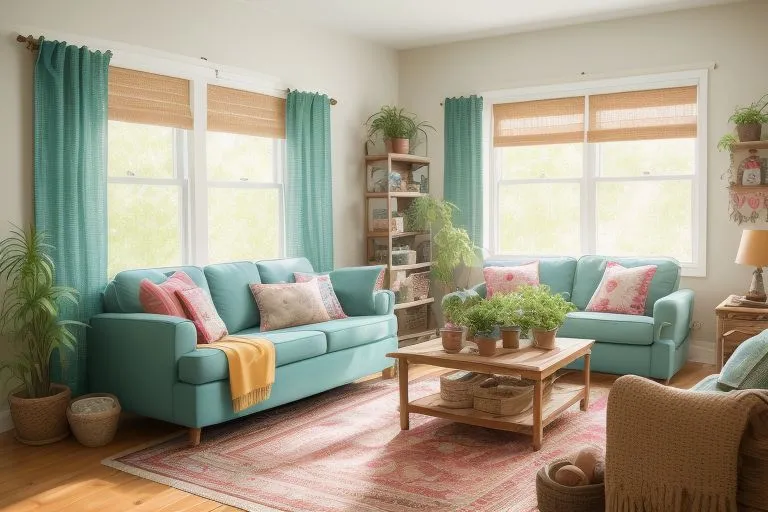
Transforming your living environment can be both rewarding and cost-effective when you embrace the art of handcrafting. Unleash your creativity and infuse new energy into your surroundings with simple, yet impactful projects.
By crafting your own decor, you not only express your unique style but also save money in the process.
These handmade decorations add a personal touch that mass-produced items simply cannot replicate.
Blank walls become canvases for custom artwork, while tables showcase eye-catching centerpieces of your own design. Upcycling breathes new life into old furniture pieces, giving them fresh looks and renewed purposes. The art of repurposing everyday objects transforms spaces through handmade decorations, upcycling, and personalized interior design, showcasing true craftsmanship.
Embracing Diy Home Décor Crafts
Unleashing your inner artist to enhance your living space provides a unique avenue for self-expression and creativity. The growing trend of crafting personalized decorations reflects a shift towards more individualized interiors.
Recent statistics reveal a 30% increase in interest for handmade décor over the past year.
This movement towards unique, creative expression allows homeowners to curate spaces that truly reflect their personalities and style preferences.
The appeal of DIY home décor lies in its ability to transform living areas into personalized sanctuaries.
Embracing handmade decorations offers multiple benefits. It’s often a budget-friendly alternative to store-bought items, with potential savings of up to 50% on average.
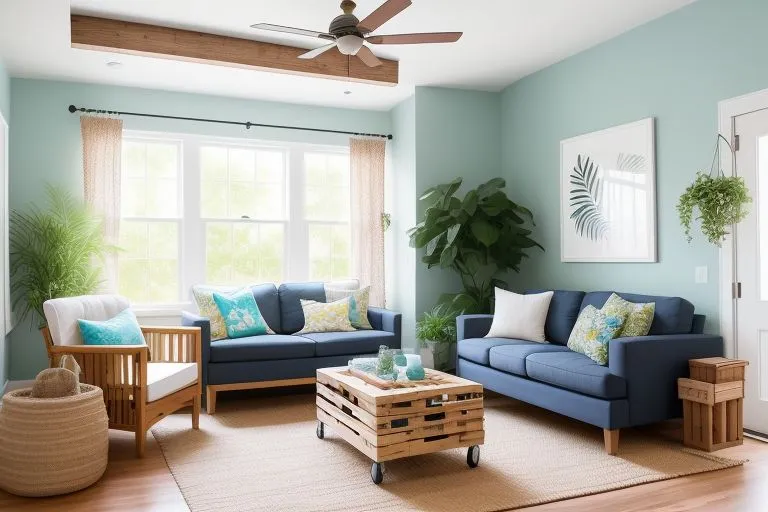
Why Choose Handmade Decorations
In the pursuit of creating a truly exceptional living space, homeowners are increasingly seeking thrifty transformations that reflect their individuality and personal style.
Handmade decorations refer to items crafted by skilled artisans, often using traditional techniques and high-quality materials.
The growing popularity of handmade decorations can be attributed to the desire for unique and personalized home decor that reflects one’s individuality.
A well-curated space can evoke emotions, create a sense of belonging, and even influence our mood.
With mass-produced decor dominating the market, it’s refreshing to see a resurgence of interest in one-of-a-kind, handmade pieces that add vintage charm to a space.
Handmade decorations offer a multitude of benefits that make them an attractive choice for those seeking stylish renovations. For instance, they provide unique accents that can elevate a room’s aesthetic, while also promoting ecofriendly materials and sustainability.
- According to a survey, 71% of homeowners prioritize unique and personalized home decor that reflects their individuality.
- A study found that 60% of consumers are willing to pay more for handmade products, citing uniqueness and sustainability as key factors.
- Handmade decorations can increase a home’s resale value by up to 15%, according to real estate experts.
- A report by the International Folk Art Market found that the global handmade market is projected to reach $3 billion by 2025, driven by consumer demand for unique and sustainable products.
Upcycling For Personalized Spaces
In the pursuit of making our living spaces a true reflection of ourselves, we often overlook the power of creative repurposing. A well-crafted, one-of-a-kind piece can transport us to a world where personality and storytelling converge.
Why Upcycling Matters
Transforming discarded materials into modern aesthetics not only reduces waste and supports sustainability but also unleashes a sense of self-expression, allowing us to curate unique statement pieces that exude our individuality.
By adopting an upcycling mindset, we can exercise our creativity while staying within budget, all while fostering a cozy atmosphere that mirrors our personality.
To embark on this creative journey, start by scouring your surroundings for materials that can be repurposed into statement pieces, wall art, or refinished furniture, evoking a cozy atmosphere and modern aesthetics through textile crafts.
Budgetfriendly Makeover Inspirations
Embracing a fresh perspective on your living space can be a liberating experience, allowing you to reimagine your surroundings without sacrificing style or your savings.
By incorporating a minimalist approach, you can breathe new life into your space without breaking the bank.
Why Budget-Friendly Makeovers Matter
Transforming spaces without breaking the bank allows homeowners to increase property value and aesthetic appeal, while also empowering individuals to take control of their living spaces.
A well-executed budget-friendly makeover can not only enhance the overall look and feel of a room, but also boost its functionality and resale value, making it an attractive option for homeowners looking to revamp their space.
Getting Creative on a Budget
One effective way to incorporate personalized style into your home decor is to experiment with unique color schemes, seasonal decor, minimalist approach, bohemian flair, lighting projects, and innovative storage solutions.
- A study by the National Association of Realtors found that homeowners can recoup up to 102% of their investment in home staging, including budget-friendly makeovers, when selling their property.
- According to a survey by the American Society of Interior Designers, 68% of homeowners believe that a well-designed space can improve their mood and overall well-being.
- The average cost of a minor kitchen remodel is around $22,500, but with budget-friendly makeover strategies, homeowners can achieve a similar look for a fraction of the cost.
- A minimalist approach to design can reduce stress and anxiety by up to 50%, according to a study published in the Journal of Environmental Psychology.
Craftsmanship In Interior Design
The beauty of a well-designed space lies not in its perfection, but in the subtle imperfections that reveal the human touch.
At its core, craftsmanship in interior design is about infusing a sense of personality and character into a room through handmade or refurbished pieces.
This can include anything from woodworking and metalwork to pottery and glass etching.
What is Craftsmanship in Interior Design?
Craftsmanship in interior design is the art of creating unique, high-quality pieces that reflect a level of skill and care.
It’s about valuing the human touch and the imperfections that come with it, rather than mass-produced, cookie-cutter designs.
In today’s world of fast-paced, disposable decor, incorporating paint techniques into your design can offer a refreshing alternative. By slowing down and focusing on the details, you can master various creative skills such as room refreshes, paint techniques, woodworking, metalwork, pottery, and glass etching.
Sustainable Living Through Diy Projects
In our quest to preserve the planet for future generations, adopting sustainable living practices has become an urgent imperative.
With the growing awareness of environmental degradation and climate change, individuals are seeking innovative ways to reduce their ecological footprint.
One effective way to adopt sustainable living is through DIY projects, which not only reduce waste but also promote creativity and self-sufficiency.
Why DIY Projects Matter in Sustainable Living
By embracing DIY projects, we can significantly reduce waste and conserve natural resources.
For instance, creating intricate mosaic designs from discarded materials not only gives old items a new lease of life but also reduces the amount of waste sent to landfills. DIY projects provide an affordable and accessible alternative to consumerism, making sustainable living more inclusive and promoting a sense of community and self-sufficiency. Through DIY projects, we can foster our creativity by exploring various art forms such as mosaic designs, macramé, needlework, floral arrangements, candle making, and paper crafts.
- According to the United Nations, the world generates over 2 billion tons of municipal solid waste annually, with at least 33% not being managed in an environmentally safe manner, making DIY projects a crucial step in reducing waste.
- A study by the National Institute of Mental Health found that engaging in creative activities like DIY projects can reduce stress and anxiety by up to 45%, promoting a sense of well-being and self-sufficiency.
- The Environmental Protection Agency estimates that 75% of the American waste stream is recyclable, but only about 30% is actually recycled, highlighting the need for innovative DIY projects that promote recycling and upcycling.
- Research by the Harvard Business Review suggests that consumers who engage in DIY projects are more likely to develop a sense of ownership and attachment to the products they create, leading to a reduction in consumption and waste.
Artistic Touches For Creative Expression
In an era where technology reigns supreme, the beauty of human creativity often takes a backseat, leaving our daily lives feeling sterile and unoriginal.
Artistic touches can play a significant role in breaking this cycle by providing an outlet for self-expression and imagination.
By reupholstering old furniture with vibrant fabrics, we can add a personal touch to our surroundings, making them feel more authentic and reflective of our personalities.
In addition to adding aesthetic value, artistic touches can also have a profound impact on our mental health and wellbeing.
Engaging in creative activities like stenciling has been shown to reduce stress and anxiety, while also promoting relaxation and calmness. Incorporating faux finishes into our home decor can evoke feelings of serenity and tranquility. By incorporating artistic touches into our daily lives, such as reupholstering, stenciling, faux finishes, window treatments, garden ornaments, and photo displays, we can unlock our full potential for creative expression.
Thrifty Transformations And Unique Accents
As we continue to seek innovative ways to reduce waste and live more sustainably, the world of home décor is embracing a refreshing trend that celebrates creativity and individuality.
By repurposing old items, you can not only reduce waste but also infuse your space with personality and character, making shelving ideas a staple in modern home decor.
Take, for instance, an old ladder transformed into a quirky bookshelf or a vintage window that becomes a one-of-a-kind storage unit, adding a touch of whimsy to your space.
This approach not only saves you money but also allows you to express your individuality and flair for design, making your home truly one-of-a-kind. When it comes to dining, upcycled materials can add a touch of elegance to your space with creative shelving ideas, charming centerpieces, vibrant throw pillows, rustic area rugs, eclectic wall hangings, and repurposed mirror frames.
Sustainable Home Decor
- According to the Environmental Protection Agency (EPA), repurposing and reusing materials can reduce waste by up to 75%.
- A study by the National Association of Home Builders found that 85% of homebuyers consider eco-friendliness an important factor when purchasing a home.
- Upcycling and repurposing materials can save homeowners up to 50% on furniture and decor costs, according to a report by the National Waste & Recycling Association.
- A survey by the American Society of Interior Designers found that 70% of homeowners prioritize sustainability and eco-friendliness when making design decisions.
Embroidery Projects Inspire Crafters Creativity
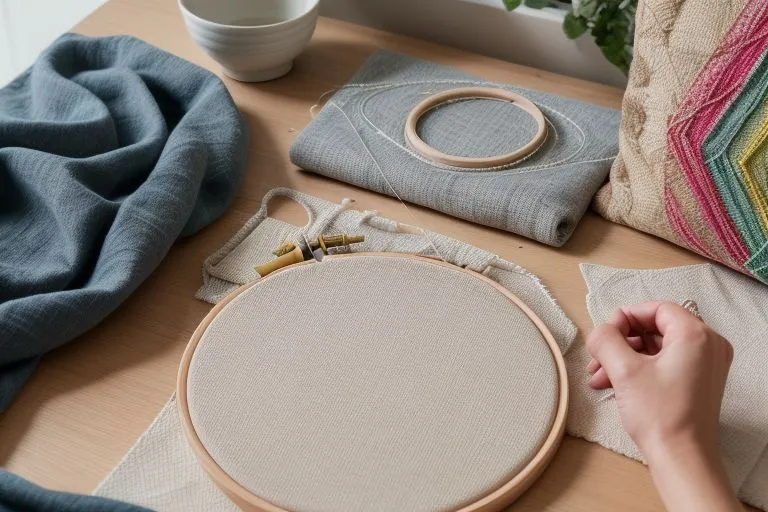
With every delicate stitch, crafters can weave together a tapestry of creativity, transporting themselves to a world of serenity and self-expression.
In today’s digital age, many crafters struggle to find inspiration and creative outlets that bring them joy and fulfillment.
With screens dominating our daily lives, it’s easy to feel disconnected from traditional crafts that bring a sense of tactile satisfaction.
The gentle rhythm of needlework provides a meditative escape from the digital world, allowing crafters to tap into their creative potential and produce unique, handmade pieces.
By working with threads of various hues and textures, crafters can quiet their minds and unleash their imagination, creating intricate designs that tell a story. Whether it’s the gentle manipulation of hoops or the delicate threading of needles, needlework requires patience and precision.
Embroidery Basics For Creative Crafters
With threads of creativity woven into every stitch, the art of embroidery has the power to transport us to a world of self-expression and imagination.
This timeless craft not only unlocks our creativity but also develops our fine motor skills and hand-eye coordination, while preserving traditional craftsmanship and cultural heritage.
Basic Tools and Materials
As you embark on your embroidery journey, having the right tools and materials is essential to bring your decorative sewing projects to life. You’ll need essential supplies like needles, threads, fabric, and hoops, and understanding how to choose the right materials for different projects is crucial.
Fabric, a critical component of handmade embroidery, is a vital element that can make all the difference in your project’s outcome. When it comes to textile art, the choice of fabric can elevate your creative expression and add a personal touch to your DIY crafts.
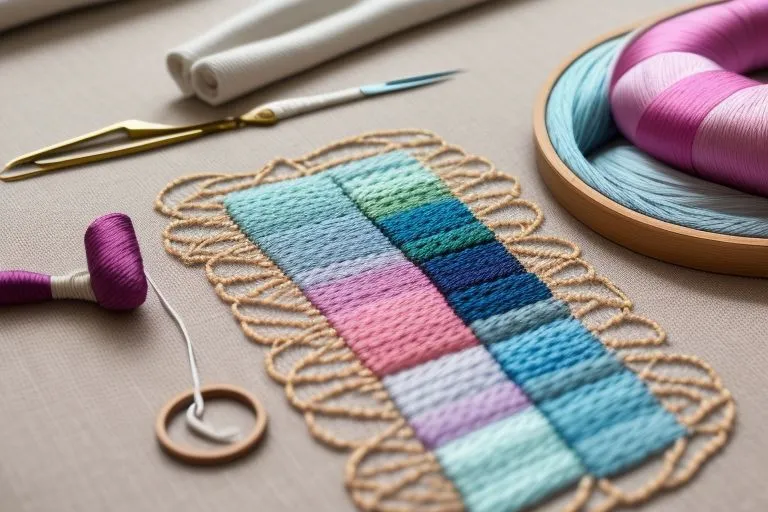
Exploring Needlework As Fiber Art
As we increasingly crave tactile experiences in our digital age, the allure of fiber arts has never been stronger, with its promise of slowing down and creating something meaningful with our own hands.
With a rich history dating back thousands of years, needlework has evolved from a purely functional activity to a highly revered form of artistic expression. From intricate embroidery to colorful appliqué, the possibilities are endless, and the benefits are numerous.
Not only does needlework develop fine motor skills and hand-eye coordination, but it also enhances creativity and self-expression, fostering patience, discipline, and attention to detail through the process of embellishment.
The sense of accomplishment and pride that comes from creating something with your own hands is unparalleled. As you delve into the world of creative hobby, you’ll discover a wide variety of exciting pursuits, including designs, appliqué, monogramming, fiber arts, and embellishment.
- Needlework has a rich history dating back thousands of years, evolving from a functional activity to a highly revered form of artistic expression.
- The benefits of needlework include developing fine motor skills and hand-eye coordination, enhancing creativity and self-expression, and fostering patience, discipline, and attention to detail.
- The sense of accomplishment and pride that comes from creating something with your own hands is unparalleled, making needlework a rewarding and fulfilling hobby.
- Needlework encompasses a wide variety of exciting pursuits, including designs, appliqué, monogramming, fiber arts, and embellishment, offering endless possibilities for creative expression.
Essential Supplies For Stitching Projects
When crafting a beautiful piece of art, the right tools can make a world of difference in the final product.
Why is it so crucial to invest in quality supplies? For starters, they directly impact the quality and longevity of your project, allowing for customization and precision.
Quality supplies matter because they ensure that your stitches are even, your colors are vibrant, and your fabric is protected from damage, making every backstitch a work of art.
In contrast, poor-quality supplies can lead to a range of issues, including thread breakage, fabric fraying, and uneven tension, ruining your aida cloth masterpiece.
This is where the importance of investing in the right tools and materials comes in. By choosing high-quality threads, needles, hoops, and scissors, you can avoid common pitfalls and ensure that your project turns out as envisioned, with every stitch carefully placed on the aida cloth, and adding unique customization with the help of a thimble and precise backstitch.
Popular Embroidery Patterns And Designs
Embroidery’s rich tapestry weaves together threads of creativity, culture, and history, offering a unique form of self-expression that transcends time and borders.
From its ancient origins to modern adaptations, satin stitch has played a significant role in shaping the craft, influenced by diverse cultures and styles that have left an indelible mark on its evolution.
The history of embroidery and its cultural significance dates back to ancient civilizations, where French knots were used to adorn clothing, symbolize status, and tell stories, showcasing the intricate craftsmanship of our ancestors.
The evolution of embroidery patterns and designs has been shaped by different cultures, resulting in a diverse range of styles, such as cross-stitch, needlepoint, and quilting, each with its unique characteristics and beauty. Today, embroidery is not only a creative outlet but also a therapeutic activity, providing a sense of calm and relaxation as you work with various craft supplies, experimenting with satin stitch, french knots, and chain stitch, while also exploring the art of needlepoint and crewel.
Mastering Different Embroidery Stitch Techniques
In the realm of textile art, a subtle ribbon of thread can weave a tapestry of self-expression, telling stories of creativity and individuality.
In the world of DIY crafts, embroidery plays a significant role, allowing individuals to personalize their fabric creations and make them truly one-of-a-kind.
With a brief history dating back to ancient civilizations, embroidery has been an integral part of various cultures, symbolizing status, power, and artistic expression through intricate beadwork and sequins.
Mastering different embroidery stitch techniques can have a profound impact on one’s creative journey, opening up new avenues for self-expression and artistic growth, as seen in the exquisite surface details of expertly crafted pieces.
By mastering various embroidery stitch techniques, individuals can enhance their creativity and confidence, allowing them to beautifully incorporate ribbon, beadwork, and sequins into their designs, experiment with couching and surface stitches, and express themselves freely through freehand embroidery.
Why Choose Embroidery For Personalization
In the realm of personalization, a subtle yet powerful art form has been quietly making a statement – one thread at a time.
One of the significant benefits of embroidery is its ability to provide a unique expression of creativity. The tactile nature of embroidery, which involves transferring stitches to fabric, allows for a deeper connection to the creative process, making each piece a true reflection of the creator’s personality and style.
Embroidery is a timeless and durable form of personalization.
Unlike other methods, the intricate whitework of embroidery can withstand wear and tear, making it a long-lasting way to add a personal touch to items.
Properly cared for, embroidered items can even become treasured family heirlooms. When it comes to gift-giving, embroidery adds a touch of thoughtfulness, especially with techniques like transferring, tambour, redwork, blackwork, whitework, and goldwork that showcase exceptional craftsmanship.
Embellishing Home Decor With Threadwork
In the quest for a truly unique and personalized living space, it’s the smallest details that often make the greatest impact.
Threadwork has a rich history in home decor, dating back to ancient civilizations where it was used to adorn clothing, tapestries, and other textiles. Today, threadwork is a versatile and accessible way to add stumpwork-inspired texture, a unique aesthetic, and a personal touch to your home decor items.
By incorporating threadwork into your decor, you can create a one-of-a-kind look that reflects your personal style and adds an extra layer of depth and visual interest to your space.
One of the key benefits of threadwork is its ability to add dimension and hardanger-like texture to your home decor. This ancient art form can elevate even the simplest of pieces, transforming them into exquisite works of art through techniques such as silk shading, stumpwork, pulled thread, drawn thread, hardanger, and smocking.
Combining Embroidery With Other Crafts
Unlocking the true potential of embroidery requires thinking beyond the confines of a single technique, and instead, embracing the endless possibilities that arise from combining it with other crafts.
Why limit yourself to just one craft? By merging embroidery with other crafts, such as quilting accents, beading, or paper crafting, you can create unique, show-stopping pieces that showcase your creativity. This fusion of techniques allows you to experiment and push boundaries, resulting in truly original art.
For instance, incorporating wearable art into your design can add an extra layer of storytelling, while upcycling old fabric can give your piece a sustainable twist.
By incorporating heirloom crafting elements, you can create treasured keepsakes that transcend generations. Ultimately, personalization through combining embroidery with other techniques, such as cutwork, quilting accents, and upcycling, allows for unique and meaningful wearable art pieces that can become heirloom crafting treasures.
Benefits of Combining Embroidery with Other Crafts
- Creates unique, show-stopping pieces that showcase creativity
- Allows for experimentation and pushing boundaries, resulting in original art
- Enables personalization, creating wearable art pieces that can become heirloom treasures
- Offers sustainable and storytelling opportunities through upcycling and incorporating wearable art
Painting And Drawing Elevate Your Craft Projects
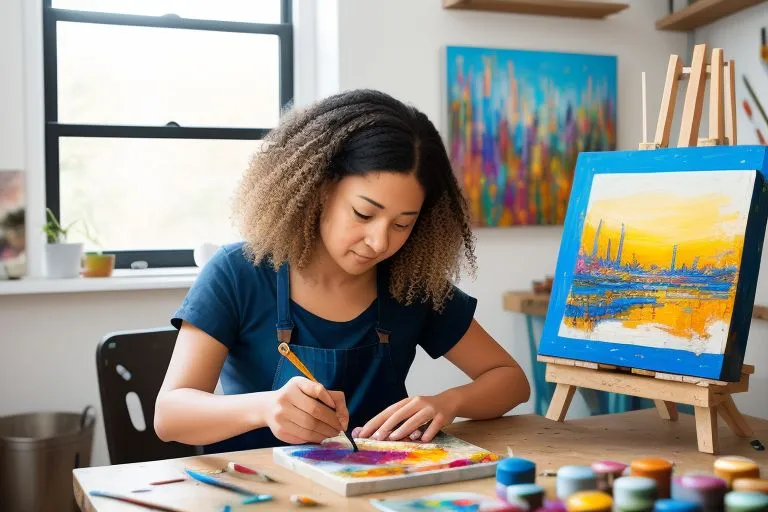
Embracing artistic expression through various mediums can revolutionize the way we approach craft projects, unlocking a wealth of creative possibilities.
One of the most significant benefits of combining painting and drawing is the ability to add a personal touch to your DIY projects. This allows you to infuse your creations with your unique perspective and style, making them truly one-of-a-kind.
Through the art of creative hobbies, painting and drawing can elevate your craft projects from ordinary to extraordinary.
By exploring the world of color theory and brushwork, you can create rich, vibrant textures and colors that bring your craft projects to life.
Incorporating customized imagery, unique illustrations, and exploring the intersection of artistic expression, creative hobbies, DIY projects, color theory, brushwork, and sketching.
Artistic Expression Through Craft Projects
As we delve into the world of creative endeavors, we often stumble upon a hidden doorway to self-awareness, emotional balance, and mental clarity.
Craft projects offer a unique means of self-discovery and emotional release, allowing us to express feelings and thoughts in a healthy and constructive way. In fact, research has shown that engaging in creative activities with oil pastels can lower cortisol levels, heart rate, and blood pressure, promoting a sense of calm and relaxation.
The tactile nature of mixed media craft projects enables us to tap into our inner world, unlocking a sense of calm and tranquility.
By engaging in activities that require precision and dexterity, such as painting with acrylics or drawing with charcoal, we can develop fine motor skills and hand-eye coordination, leading to improved overall development and coordination. This unique piece of art combines mixed media, canvas preparation, acrylics, watercolors, oil pastels, and charcoal.

Creative Hobbies For Beginners
Embracing a creative pursuit can revolutionize the way we perceive ourselves and the world around us, offering a fresh perspective on life.
Research has shown that creative expression can have a profound impact on mental and emotional well-being, reducing stress and anxiety while promoting feelings of calm and relaxation.
By incorporating creative hobbies into daily life, individuals can experience a significant boost in confidence and self-esteem, leading to a more fulfilling and purpose-driven life.
One of the most significant benefits of creative hobbies is their ability to tap into the subconscious mind, allowing individuals to access and express deep-seated emotions and thoughts.
This process of creative expression can be incredibly cathartic, providing a healthy outlet for emotions and promoting emotional balance. Whether it’s capturing still life compositions, crafting abstract designs, or experimenting with texture and color, creative hobbies offer a unique window into the human experience. By engaging in creative explorations of perspective, still life, landscapes, abstract designs, texture, and palette knife techniques, artists can unlock new dimensions of self-expression.
| Benefits of Creative Expression | Impact on Well-being |
|---|---|
| Reduces stress and anxiety | Boosts confidence and self-esteem |
| Provides a healthy outlet for emotions | Promotes emotional balance and calm |
| Taps into the subconscious mind | Unlocks new dimensions of self-expression |
Essential Art Supplies For Crafting
As creatives continue to push the boundaries of imagination, the art of crafting has become an integral part of self-expression and artistic identity.
Unlocking Creative Potential
Crafting is more than just a leisure activity; it’s an art form that requires dedication, practice, and the right tools to bring ideas to life.
By blending traditional techniques with modern materials, crafters can unlock new levels of creativity and artistic vision.
With the right art supplies, crafters can refine their skills, explore new mediums, and create truly unique pieces that reflect their personality.
By investing in essential art supplies, crafters can enhance their craftsmanship, precision, and overall creative expression. This investment not only yields better results but also fosters a sense of pride and accomplishment. A well-stocked easel, a set of versatile pencils, and a trust in one’s artistic vision are the essential elements necessary for artfully blending art supplies on easels and in sketchbooks with careful precision, guided by erasers.
DIY Painting Techniques To Try
As you dip your brush into the vibrant world of color, the possibilities are endless, and the journey is just as important as the destination.
Unlocking Creativity and Expression is a significant benefit of DIY painting techniques. By tapping into your creative side, you can experience the therapeutic benefits of self-expression through painting, which becomes a form of storytelling that conveys emotions and thoughts in a unique and personalized way, much like using fixatives to preserve your masterpiece.
One of the most exciting aspects of DIY painting is the freedom to explore different techniques, which can evoke therapy-like sensations.
Wash and blending can create soft, gradient-like effects, while dripping and splattering can achieve dynamic, abstract patterns. Stenciling and masking add precision and detail to your art, allowing you to tell your story through self-expression and therapy.
| Benefits of DIY Painting | Techniques | Effects |
|---|---|---|
| Unlocking Creativity and Expression | Wash and Blending | Soft, Gradient-like Effects |
| Therapeutic Benefits of Self-Expression | Dripping and Splattering | Dynamic, Abstract Patterns |
| Telling Your Story Through Art | Stenciling and Masking | Precision and Detail |
Why Choose Painting As Hobby
As we navigate the complexities of modern life, many of us seek activities that bring us joy, relaxation, and a sense of fulfillment, and that’s where painting comes in, offering a unique blend of creativity, self-expression, and personal growth.
Discovering individuality through art, inspired by famous artists, allows you to break free from conventional thinking, finding confidence in creative endeavors that bring out the best in you, unlocking your true potential.
Reducing stress and anxiety through art therapy has been shown to foster mindfulness and presence, ultimately boosting mood and overall mental health, providing a healthy escape from the pressures of everyday life.
Joining art classes and workshops provides opportunities to connect with like-minded individuals, sharing creativity and inspiring others, while learning from tutorials and gaining new inspiration. The website features a wide range of resources, including workshops, tutorials, inspiration, history, famous artists, and movements.
Brushwork Basics For Crafters
Elevating your craft to a professional level requires a deep understanding of the intricate dance between brush and medium.
Why Brushwork Matters
Proper brush handling and care are essential to achieve exhibitions that showcase your craftsmanship and taking your creative projects to the next level.
Masterful brushstrokes can enhance your creative expression, unlock new techniques, and effects with diverse brush types.
With the right brushwork skills, you can create stunning pieces that showcase your unique style and flair.
Understanding Brush Anatomy
When it comes to upcycling old pieces or creating new ones, natural fibers are ideal for water-based mediums, while synthetic fibers work well with acrylics and oils. Brush shapes and sizes vary, and choosing the right one depends on the project’s requirements.
A good brush head and handle combination can make a significant difference in your overall portfolio. The course focused on Essential skills such as exhibitions, portfolio development, critique, craftsmanship, upcycling, and decorative techniques.
Brushwork
- Masterful brushstrokes can enhance creative expression and unlock new techniques and effects.
- Natural fibers are ideal for water-based mediums, while synthetic fibers work well with acrylics and oils.
- A good brush head and handle combination can make a significant difference in an artist’s overall portfolio.
- Proper brush handling and care are essential to achieve exhibitions that showcase craftsmanship.
Mixed Media In Craft Projects
In the realm of craft projects, embracing diversity and pushing creative boundaries has become a hallmark of artistic innovation, allowing crafters to transcend traditional norms and unlock unseen potential.
Defining mixed media art as a fusion of different artistic mediums, it has become a cornerstone of modern crafting, allowing artists to experiment and express themselves in innovative ways, often incorporating faux finishes and stenciling techniques. The evolution of mixed media art has transformed it from traditional forms to contemporary styles, embracing new materials and techniques.
The role of mixed media in promoting creative expression and experimentation cannot be overstated, as it encourages artists to think outside the box and explore uncharted territories, often leading to the creation of unique miniatures and murals. This freedom to experiment has led to the development of new styles and techniques, such as faux finishes, stenciling, decoupage, murals, miniatures, and zentangle, further expanding the possibilities.
Personalized Creations With Paint
From the intricate strokes of a painter’s brush to the vibrant colors that dance across a canvas, art has long been a powerful medium for self-expression and emotional connection.
With the rise of personalized creations, artists and art enthusiasts can now tap into the profound impact of customized art, elevating it from mere decoration to a powerful means of emotional connection and storytelling.
In the realm of nature-inspired art, for instance, a skilled painter can weave together intricate patterns and colors to evoke a sense of serenity, transporting the viewer to a tranquil environment, perfect for seasonal decor.
This form of creative expression not only resonates with the artist but also with those who experience the artwork, fostering empathy and connection, making it an ideal gift idea for loved ones. Mandalas provide a unique opportunity to showcase nature-inspired and seasonal gift ideas through personalized decor and creative expressions.
| Benefits of Customized Art | Description |
|---|---|
| Elevates Emotional Connection | Fosters empathy and connection with the viewer |
| Unique Gift Idea | Ideal for loved ones, showcasing personalized decor and creative expressions |
| Transports to a New Environment | Evokes a sense of serenity, transporting the viewer to a tranquil environment |
Candle Making Illuminates The World Of Crafting
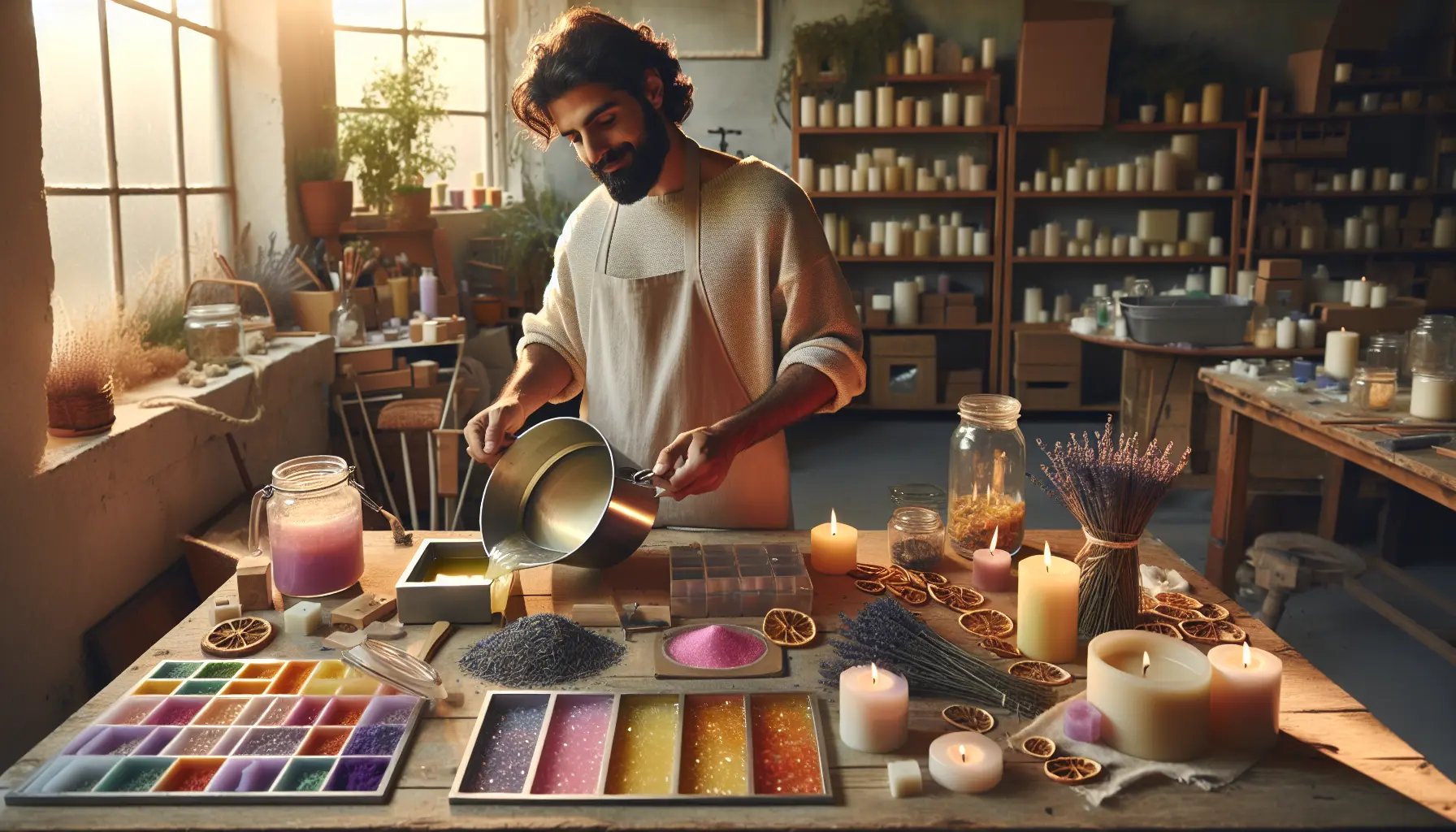
As the soft glow of a candle flickers to life, it’s hard not to feel a sense of tranquility wash over you, and yet, this serene ambiance is just the beginning of the candle making journey.
Candle making is a unique DIY craft project that offers a wide range of benefits, combining wax crafting and relaxation with personalized gift-giving, while providing an eco-friendly alternative to commercial candles and fostering self-expression and creative freedom. One of the most significant benefits of candle making is its therapeutic effects, as the gentle process of scented soy fusion can be meditative, reducing stress and anxiety, while the sense of accomplishment that comes with creating something with your own hands provides a lasting feeling of pride and fulfillment.
Introduction To Candle Making Crafts
In the realm of creative pursuits, few activities offer the same level of tranquility and satisfaction as crafting a candle from scratch, carefully selecting fragrance oils to evoke a sense of serenity.
Today, it has evolved into a popular hobby that not only provides a sense of accomplishment but also offers numerous benefits for one’s mental and emotional well-being.
Historically, candle making was a necessary skill for providing light, but it has since transformed into a form of self-care and relaxation, allowing individuals to personalize their creations with unique dye blocks.
In modern times, DIY crafts like candle making have gained popularity as people seek unique and personalized ways to express themselves, experimenting with different container selection options.
Candle making offers a multitude of benefits, including stress relief and mental wellness, development of creative skills through the manipulation of fragrance oils, dye blocks, container selection, double boiler, temperature control, and pour techniques.
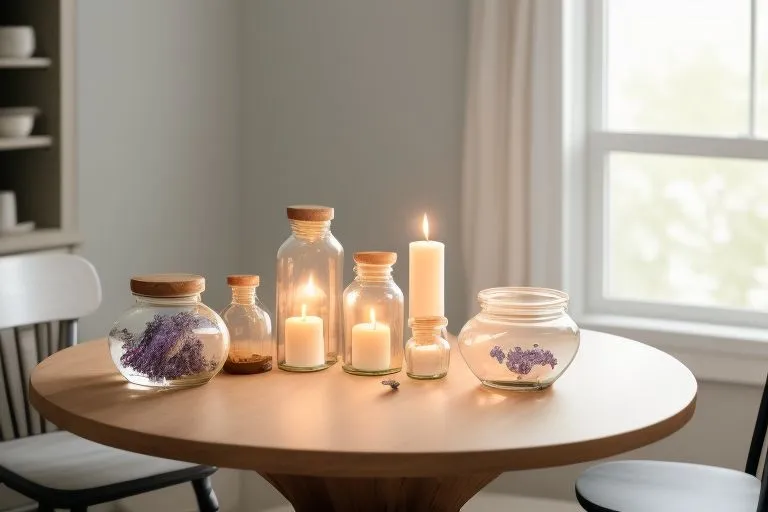
Essential Supplies For Wax Crafting
As artists and crafters continue to push the boundaries of creativity, the demand for unique and personalized decorative pieces has given rise to a thriving community of wax crafters, each seeking to layer colors and bring their vision to life.
Whether you’re a seasoned crafter or just starting out, having the right tools and materials is crucial for successful projects, allowing you to achieve intricate taper shaping and precision that elevates your craft from amateur to artisan.
Introduction to Wax Crafting
In recent years, wax crafting has experienced a surge in popularity, with many enthusiasts drawn to its ecofriendly materials and creative possibilities, from delicate embedded objects to stunning pillar designs. The right supplies can make all the difference between a mediocre project and a truly exceptional one, enabling you to create floating candles that seem to defy gravity through expert layering of colors, strategic embedding of objects, innovative use of ecofriendly materials, precise taper shaping, and thoughtful pillar designs.
| Wax Crafting Benefits | Importance of Right Supplies |
|---|---|
| Ecofriendly materials | Enables precision and intricate taper shaping |
| Creative possibilities (e. g. embedded objects, pillar designs) | Makes a difference between mediocre and exceptional projects |
| Allows for innovative use of materials and designs | Essential for achieving expert layering of colors and strategic embedding |
Choosing The Right Container Selection
Crafting the perfect candle requires more than just the right wax and wick; it’s also about centering your attention on the often-overlooked container.
Understanding Container Options
Selecting the right container for your candle can be overwhelming with the numerous options available, including glass, metal, ceramic, and more.
It’s essential to understand that each material has its benefits and drawbacks, which can significantly impact the overall quality and performance of your candle, particularly during the cooling process.
For instance, glass containers offer excellent heat resistance and visibility, allowing for a clean and elegant appearance with decorative touches. On the other hand, metal containers are durable and provide excellent heat conductivity, but may not be suitable for certain types of wax, such as gel wax, which requires careful marbling effects, precise centering, and a slow cooling process to achieve decorative touches while following essential safety precautions.
How To Prepare Scented Soy
As a crafter, you’re likely drawn to unique materials that offer endless creative possibilities and a clear conscience. Fortunately, scented soy fits the bill perfectly, offering a versatile and eco-friendly medium for DIY projects that exude warmth and character.
When it comes to scented soy, understanding its benefits is key to unlocking a world of possibilities.
This renewable resource is not only biodegradable but also boasts a lower melting point, making it ideal for crafters who want to create distinctive and environmentally sustainable products that incorporate aromatherapy blends.
Selecting the Perfect Soy Wax for Your Project
To get started, it’s essential to choose the right type of soy wax for your scented soy creations. Look for high-quality soy wax flakes or granules specifically designed for making aromatherapy blends, natural additives, mason jar luminaries, rustic farmhouse style, vintage teacup votives, and homemade gifts.
Scented Soy
- Scented soy is a renewable resource that is biodegradable and has a lower melting point, making it ideal for crafters who want to create environmentally sustainable products.
- High-quality soy wax flakes or granules are specifically designed for making aromatherapy blends, natural additives, and homemade gifts.
- Scented soy offers a versatile and eco-friendly medium for DIY projects that exude warmth and character.
- Soy wax is perfect for creating distinctive products that incorporate aromatherapy blends, such as mason jar luminaries and vintage teacup votives.
Mastering The Melting Pot Technique
In the realm of artisanal candle making, the melting pot technique stands as a beacon of creative liberation, allowing crafters to transcend conventional boundaries and unleash their unique vision.
By mastering this technique, candle makers can break free from the limitations of pre-made molds and DIY workshops, experimenting with unique shapes and designs that reflect their personal style. This creative freedom allows for the development of intricate patterns and designs, making each candle a one-of-a-kind masterpiece.
With the ability to blend colors effortlessly, candle makers can adopt sustainable crafting practices that reduce waste and promote eco-friendliness.
This technique also enables the creation of intricate patterns and designs, adding an extra layer of sophistication to the final product. A deep understanding of the melting pot technique enables crafters to experiment with various creative projects, including DIY workshops, sustainable crafting, meltandpour kits, handdipped tapers, multiwick creations, and textured surfaces.
Why Use EcoFriendly Materials
As consumers increasingly prioritize environmental responsibility, the demand for sustainable products is driving innovation in industries like candle making and DIY crafts.
The environmental impact of traditional materials is a pressing concern, contributing to landfills and pollution, and harming wildlife and ecosystems.
In contrast, ecofriendly materials offer a range of benefits, starting with a reduced carbon footprint, lower toxicity levels, and improved indoor air quality when using custom molds.
One significant advantage of ecofriendly materials is the unique opportunities they provide for creative expression, allowing artisans to experiment with seasonal scents and unconventional designs that not only reduce waste but also promote innovation.
In addition, sustainable resources play a vital role in DIY craft projects, incorporating renewable energy sources, upcycled containers, and recycled materials in craft supplies. This not only reduces waste but also encourages creativity and imagination. Flameless alternatives and burning time calculations provide more flexibility.
Exploring Creative Pour Techniques
When it comes to creating truly unique and captivating homemade candles, the key to success lies in mastering the art of creative pour techniques, which can elevate your DIY craft projects from ordinary to extraordinary.
Unlocking Unique Textures and Patterns
Understanding the role of temperature and viscosity is crucial in achieving desired effects.
By experimenting with advanced techniques, such as layered pouring and color blocking, you can create unique textures and patterns that add an extra layer of visual interest to your homemade wax creations.
Breaking Free from Traditional Candle Making
Thinking outside the mold can lead to innovative ways of using pouring techniques, elevating your DIY craft projects to new heights.
With creative pouring, the possibilities are endless, and the results are often breathtaking, allowing you to showcase your personalized packaging ideas and stand out from the crowd. Exploring Packaging Ideas, Beginner-Friendly Projects, Advanced Techniques, Color Psychology, Essential Oil Blending, and Troubleshooting.
DIY Workshops For Beginners
Unlock the satisfaction of creating something with your own hands, and discover a world where self-expression, sustainability, and community building converge.
One of the most significant benefits of DIY workshops is the sense of accomplishment and pride that comes with crafting a unique product from scratch, allowing you to craft artisanal production that reflects your personal style.
In today’s consumption-driven society, DIY workshops offer a refreshing alternative, promoting ecoconscious practices that reduce waste and foster a sense of resourcefulness. By taking up DIY projects, you’re not only creating something new but also reducing your carbon footprint with ecoconscious packaging. DIY workshops provide a platform for self-expression, experimentation, and innovation, allowing you to unleash your inner artist and curate a personalized gift set that showcases your creativity, complete with personalized labels, artisanal production, ecoconscious packaging, and care instructions, perfect for showcasing on online selling platforms.
Benefits of DIY Workshops
- 95% of DIY enthusiasts report a sense of pride and accomplishment after completing a project, according to a survey by the DIY Network.
- DIY projects can reduce waste by up to 75% by repurposing materials and reducing packaging, as reported by the Environmental Protection Agency.
- 71% of consumers prefer to buy from businesses that have a strong commitment to sustainability, making DIY workshops a valuable asset for entrepreneurs, according to a study by Nielsen.
- The global DIY market is projected to reach $9 billion by 2025, growing at a CAGR of 3% from 2020 to 2025, according to a report by Grand View Research.
Soap Making Transforms Everyday Crafting
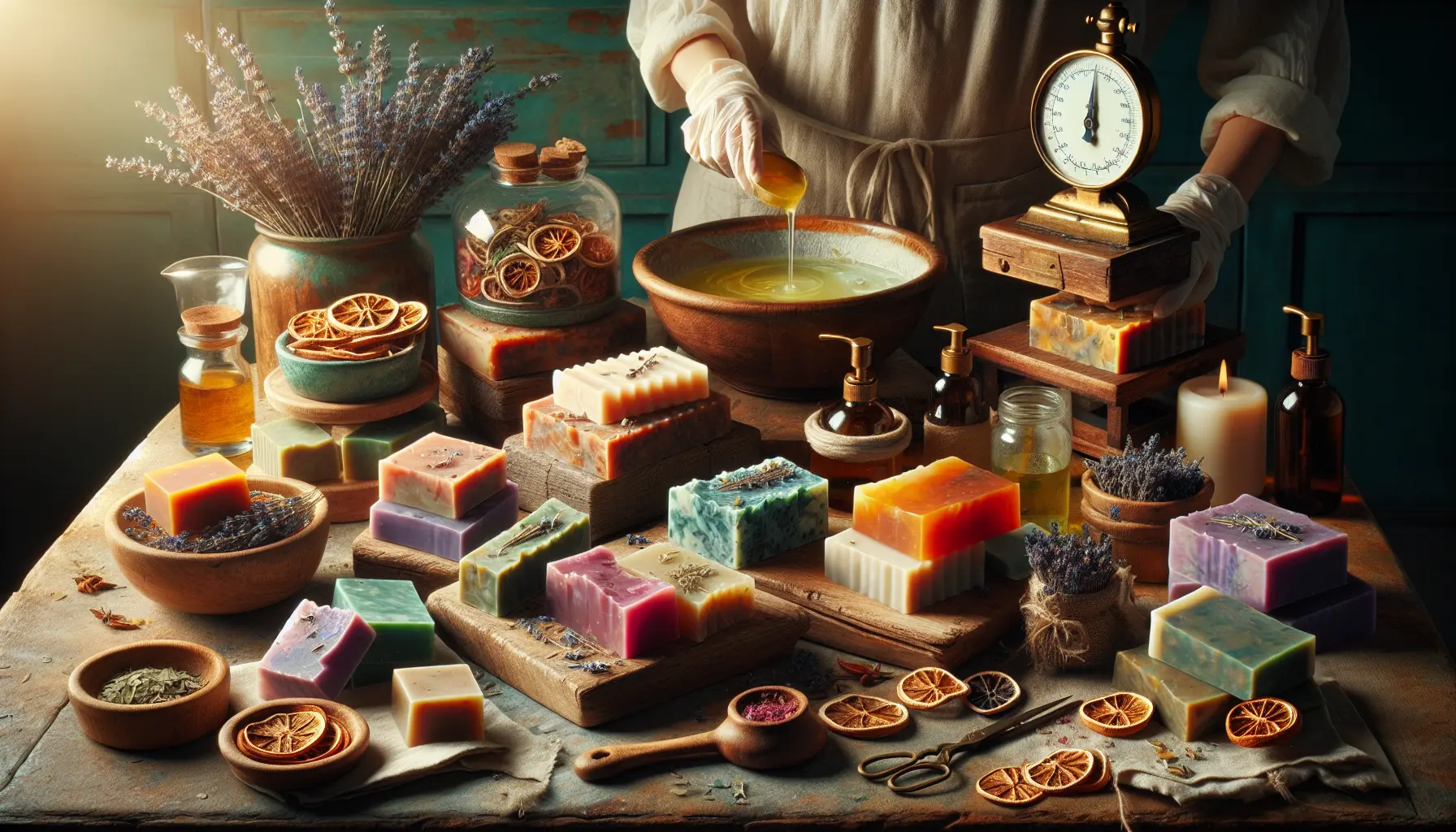
Crafting has evolved into a platform where individuals can express their creativity, and the art of soap making has become an integral part of this movement. Every year, millions of crafty individuals seek unique and creative ways to express themselves, but few know the benefits of soap making.
With the rise of DIY culture, soap making has become an attractive outlet for those looking to create something truly personalized and beneficial.
In contrast to commercial soap, the saponification process involved in handcrafted soap making allows for complete control over the ingredients and customization options.
This results in a product that is not only gentle on the skin but also environmentally friendly. The use of essential oils and lye in precise measurements enables crafters to create unique, handcrafted soaps through the process of saponification, often incorporating glycerin and pouring into molds.
Introduction To Artisanal Soap Making
In an era where self-care and individuality are paramount, the ancient craft of soap making has evolved to cater to diverse skin types and preferences, promising a more personalized cleansing experience.
Unlocking the benefits of handcrafted soap lies in its ability to provide a tailored experience for individual skin types and preferences. This shift towards customization is driven by the growing awareness of the harsh chemicals found in commercial soaps, leading many to seek out natural ingredients and unique fragrance combinations.
Artisanal soap makers have been pushing the boundaries of creativity, incorporating exfoliants like oatmeal and natural colorants such as spirulina to create a wide range of textures and hues.
This freedom to experiment has led to the development of truly unique and effective soap recipes, which undergo a careful curing process to ensure maximum quality. Our soap making techniques include both cold process and hot process methods, incorporating a variety of fragrance options, natural colorants, exfoliants, and careful curing.
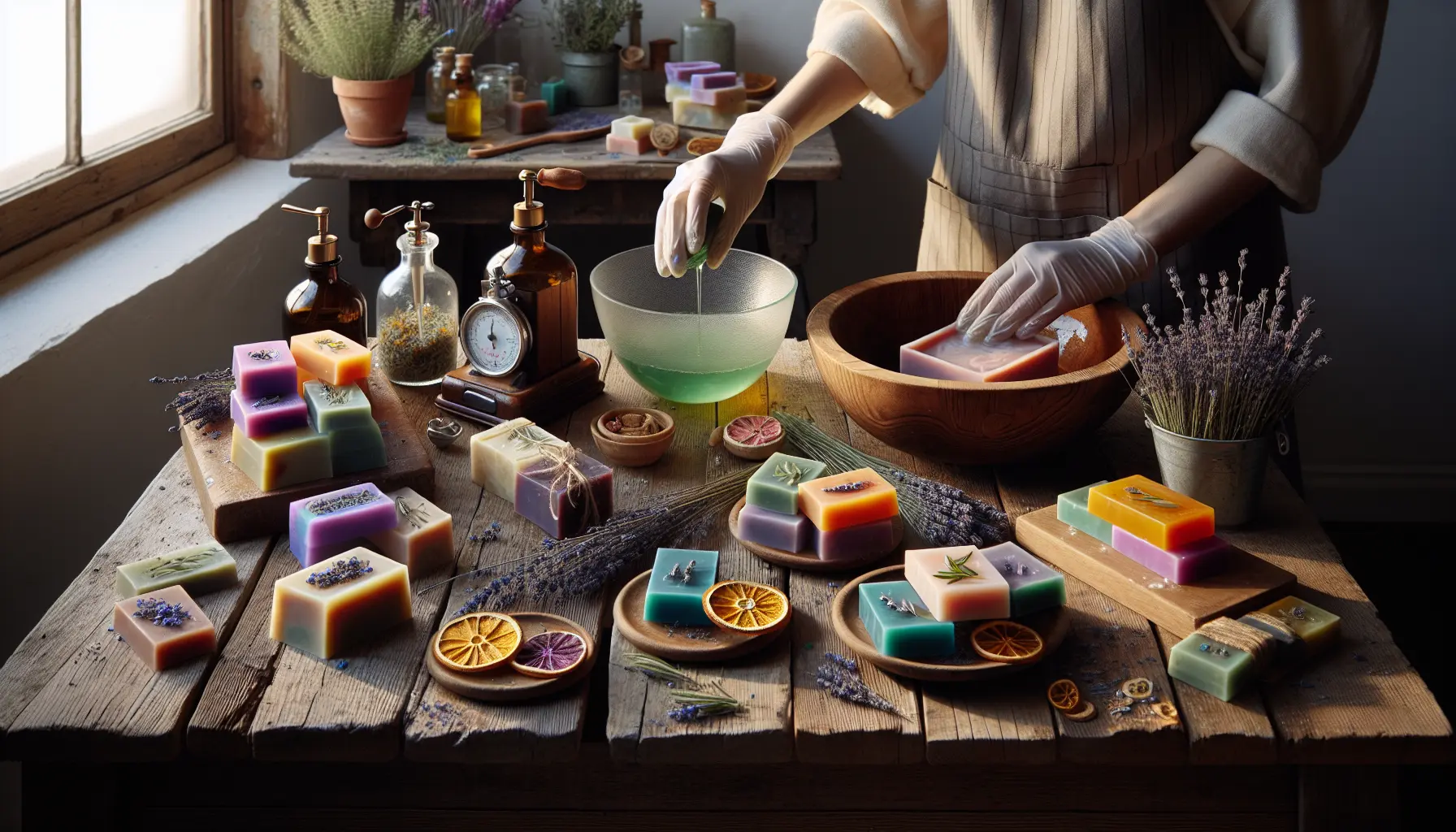
Essential Ingredients For Handcrafted Soaps
When it comes to crafting artisanal soaps that truly care for the skin, the devil lies in the details, and it all begins with the selection of high-quality trace elements that work in harmony to create a nourishing experience.
Handcrafted soaps have gained popularity for their natural and nourishing properties, and the importance of essential ingredients cannot be overstated. Understanding the role of these ingredients can help soap makers create effective and beneficial products that stand out in a crowded market.
Natural oils and butters, such as coconut, olive, and shea, provide moisturizing properties that superfat the skin, leaving it feeling soft and supple.
These base oils help to create a rich, creamy lather that is the hallmark of a well-crafted, DIY soap. The artisanal DIY enthusiast carefully selected the superfat and base oils to create a custom skin care product, tracing every step of the process to ensure perfection.
Artisanal Soaps
- Natural oils and butters, such as coconut, olive, and shea, provide moisturizing properties that superfat the skin, leaving it feeling soft and supple.
- Handcrafted soaps have gained popularity for their natural and nourishing properties, and the importance of essential ingredients cannot be overstated.
- The selection of high-quality trace elements is crucial in creating a nourishing experience for the skin.
- A well-crafted, DIY soap is characterized by a rich, creamy lather that is achieved through the careful selection of superfat and base oils.
Understanding The Saponification Process
Unlocking the secrets of soap making begins with a profound appreciation for the intricate dance of fatty acids and alkalis, a union that gives birth to a vast world of moisturizing possibilities.
At its core, saponification is a chemical reaction that involves the combination of fatty acids and an alkali to produce soap. This process has been refined over centuries, with ancient civilizations using ash and plant-based oils to create crude soaps.
Today, mastering the saponification process is essential for crafting bespoke cleansing bars that cater to diverse skin types and preferences.
By grasping the underlying chemistry, soap makers can control the quality and texture of their final product, creating customized recipes infused with unique additives and herbal infusions. A brief history of soap making reveals a steady evolution, from ancient Mesopotamia to modern-day craftsmen creating moisturizing, cleansing bars through rebatching, incorporating additives, and infusing herbal botanicals.
Cold Process Vs Hot Process
As the artisanal soap-making community continues to flourish, enthusiasts are increasingly curious about the intricacies of this ancient craft, particularly when it comes to the two primary methods that dominate the industry.
Understanding the basics of soap making is essential before diving into the world of Cold Process and Hot Process.
Soap making involves mixing oils, fats, and lye to create a chemical reaction that produces soap, often incorporating swirling techniques to achieve unique textures.
This ancient craft has been around for thousands of years, with evidence of soap making dating back to ancient civilizations such as the Egyptians and Greeks, who likely used palm-free ingredients in their recipes.
The two main methods of soap making, Cold Process and Hot Process, differ significantly in their approach. Cold Process soap making involves mixing oils and lye at room temperature, allowing the mixture to blend slowly, which creates a beautiful, unique design using swirling techniques and layering, and can be palm-free and vegan, without using tallow.
Soap Making
- Evidence of soap making dates back to ancient civilizations such as the Egyptians and Greeks.
- Soap making involves mixing oils, fats, and lye to create a chemical reaction that produces soap.
- Cold Process soap making allows for the creation of unique designs using swirling techniques and layering.
- Cold Process soap making can be palm-free and vegan, without using tallow.
Choosing Molds And Essential Oils
Crafting unique and effective soaps requires a deep understanding of the interplay between ingredients, textures, and presentation. In this delicate balance, the right molds and essential oils can elevate your creations from ordinary to extraordinary.
Unlocking the Full Potential of Your Soap Creations
The shape and size of a mold play a significant role in achieving the desired soap design, with high olive oil content recipes often requiring larger molds to accommodate soft and pliable textures.
Different materials, such as silicone, metal, and plastic, also impact soap quality and release, with silicone molds preferred for their flexibility and ease of release, while metal molds produce a more rustic, textured soap. When selecting molds for specific recipes, factors like coconut oil content, soap hardness, and temperature must be considered, along with the type of milk used, such as goat milk, and the addition of nourishing ingredients like shea butter and olive oil, as well as the use of caustic soda and pH testing.
Natural Colorants And Exfoliants
As the beauty industry evolves, a spotlight is being shone on the importance of unmolding harmful chemicals from our daily routines, and instead, opting for a more natural approach.
For centuries, natural colorants and exfoliants have been used in beauty products, with a rich history dating back to ancient civilizations.
With the advent of synthetic ingredients, many of these natural ingredients were replaced by cutting-edge technology.
Today, there is a growing movement towards moving away from synthetic ingredients and embracing natural alternatives.
This shift is driven by the importance of sustainability, gentle skin care, and the desire for more natural beauty products, which involves careful labeling and consideration.
Natural colorants and exfoliants offer a range of benefits, from being rich in antioxidants and anti-inflammatory properties to providing natural UV protection and enhancing skin texture and appearance. These ingredients are also used in the processes of unmolding, cutting, stamping, packaging, labeling, and following safety precautions.
| Benefits of Natural Colorants and Exfoliants | Characteristics |
|---|---|
| Rich in Antioxidants and Anti-Inflammatory Properties | Provide Natural UV Protection |
| Enhance Skin Texture and Appearance | Gentle on Skin |
Curing And Packaging Your Creations
In the world of handmade beauty products, the unseen heroes are often the ones that ensure long-term success, specifically the processes that take place after the mixing and blending are complete.
Proper curing and packaging techniques are essential for maintaining the quality and shelf life of your handmade creations.
Preservatives play a vital role in preventing the growth of bacteria and mold, while antioxidants help to protect the product from oxidation and spoilage.
From butters and waxes to precision temperature control with a thermometer, every element counts in the DIY craft project journey.
Whether you’re crafting unique skincare solutions or indulging in creative pursuits like candle-making, understanding the curing process and its importance in ensuring your creations reach their full potential is vital.
Why Try DIY Soap Making
Unlock the power of natural ingredients and take the first step towards a healthier, more radiant you.
Creating your own soap recipes allows you to harness the nourishing properties of oatmeal and shea butter, providing gentle care for your skin. By steering clear of harsh chemicals and artificial fragrances commonly found in commercial soaps, you can enjoy a more natural and effective cleansing experience.
Making your own soap gives you the opportunity to contribute to a greener environment.
By reducing waste and packaging, and opting for sustainable ingredients, you can make a positive impact on the planet’s ecosystem.
DIY soap making offers a fun and creative outlet, allowing you to experiment with unique textures and colors using mica powders and exfoliating ingredients like poppy seeds. As the artisan carefully mixed the ingredients, she added a blend of clays, loofah, oatmeal, poppy seeds, mica powders, and titanium dioxide.
Benefits of Making Your Own Soap
- Using natural ingredients like oatmeal and shea butter provides gentle care for your skin and a more natural cleansing experience.
- Making your own soap allows you to reduce waste and packaging, and opt for sustainable ingredients, contributing to a greener environment.
- DIY soap making offers a fun and creative outlet, enabling you to experiment with unique textures and colors using various ingredients like mica powders and exfoliating ingredients.
- By avoiding harsh chemicals and artificial fragrances, you can enjoy a healthier and more radiant skin.
Crochet Projects Inspire Creativity And Craft
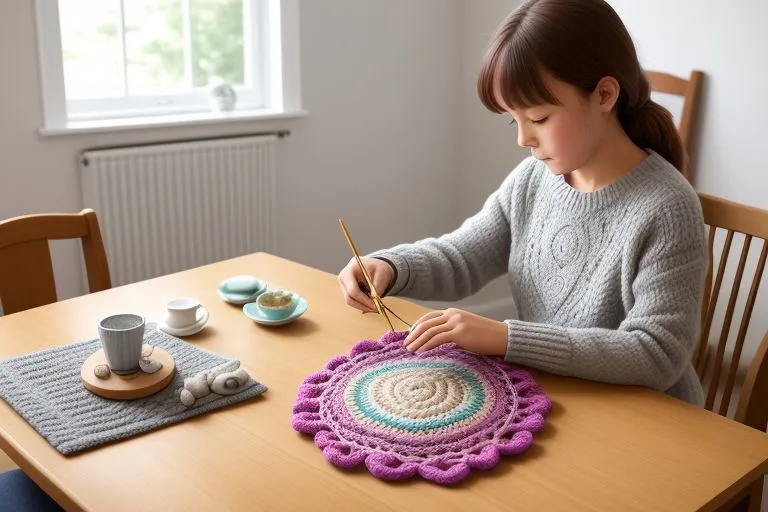
Fiber arts offer a gateway to boundless imagination and personal expression. Needles and yarn transform into tools of artistic discovery, unveiling a world of creative possibilities.
Engaging in these projects provides numerous benefits, including stress relief and improved hand-eye coordination.
The craft boosts self-esteem as you witness your creations come to life, fostering a sense of accomplishment with each completed piece.
Exploring the creative process involves selecting materials, experimenting with stitches, and customizing designs to suit your unique vision. This journey in yarn crafting fosters a sense of community through online forums, local workshops, and collaborative projects. The art form also promotes sustainability by encouraging the use of natural fibers and upcycled materials to create handmade accessories and decorative items like amigurumi and granny squares.
Introduction To Yarn Crafting
Delve into the world of fiber arts and discover a rewarding pastime that offers numerous advantages. This engaging hobby provides a wealth of benefits for both mind and body, making it an excellent choice for creative individuals seeking a fulfilling activity.
Therapeutic benefits: The repetitive motions involved in stitch patterns can significantly reduce stress and promote mindfulness.
This creative hobby allows practitioners to focus their attention, leading to a meditative state that calms the mind and enhances overall well-being.
The rhythmic nature of textile design techniques often induces a sense of relaxation and inner peace.
Skill development: Engaging in DIY decor projects enhances fine motor skills and hand-eye coordination across all age groups. These activities may also contribute to cognitive improvements through engaging in creative hobbies like stitch patterns, textile design, DIY decor, wearable crafts, and needlework.
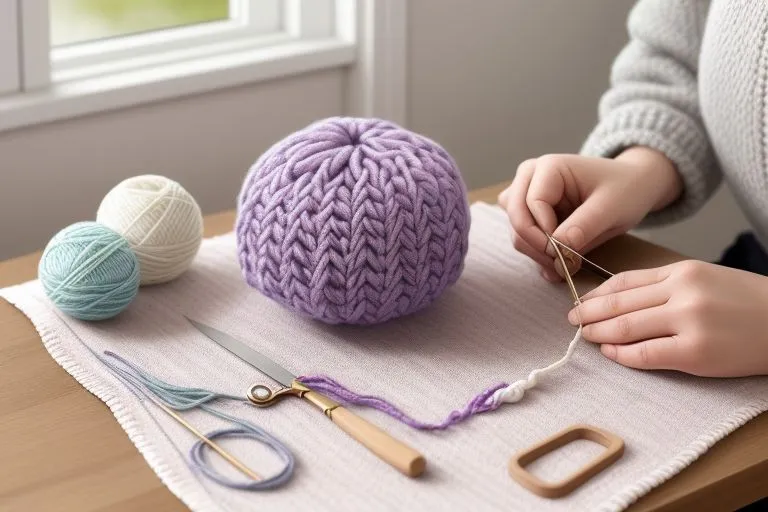
Choosing The Right Crochet Hook
Embarking on a crochet journey begins with understanding the tools of the trade. The foundation of your craft lies in selecting the perfect implement for your project.
Mastering this art requires knowledge of hook sizes and materials, which is crucial for achieving desired results.
Metric and US sizing systems are commonly used, with metric measurements providing more precise gradations for tactile textures.
Hook materials offer a diverse range of options, including aluminum, steel, plastic, and wood. Each material presents unique benefits for different yarn types and project requirements.
Matching hooks to yarn weight is essential for proper tension and stitch appearance. Consult a chart of recommended hook sizes for various yarn types to ensure compatibility when creating cozy blankets.
Ergonomics play a vital role in crochet comfort, especially during extended crafting sessions. Consider grip styles for crocheting cozy blankets and colorful afghans with decorative motifs and tactile textures, from beginner-friendly to advanced techniques.
Essential Stitches For Beginners
Mastering fundamental techniques empowers beginners to create beautiful, functional pieces with confidence and skill.
Building a Strong Foundation
Learning essential stitches is crucial for developing craftsmanship and expanding your crochet repertoire.
These basic techniques form the backbone of countless vintage-inspired designs and patterns.
By mastering fundamental stitches, beginners can quickly progress to more complex projects, allowing them to explore seasonal decorations and personalized gift ideas.
What Is Amigurumi
The enchanting realm of miniature crochet dolls and figures has captivated crafters and art enthusiasts worldwide. This charming Japanese art form involves creating small, stuffed yarn creatures that have gained global popularity.
These adorable creations are known for their compact size and cute appearance, offering a delightful heirloom pieces for generations to enjoy.
Characterized by their three-dimensional structure and versatile design possibilities, these tiny treasures allow crafters to express their creativity through mindful making.
The process of creating these miniature marvels involves specific materials and techniques. Soft, smooth yarns are typically used to achieve the desired texture and appearance. Essential tools for this craft include crochet hooks, stuffing, and safety eyes, while basic stitches like single crochet and increases/decreases form the foundation for creating heirloom pieces through mindful making and sustainable crafting techniques.
Miniature Crochet Dolls
- Originated as a Japanese art form and gained global popularity
- Characterized by three-dimensional structure and compact size
- Requires specific materials like soft yarns, crochet hooks, and safety eyes
- Utilizes basic stitches such as single crochet and increases/decreases
Creating Cozy Blankets And Afghans
As the temperatures drop, our homes become our sanctuaries, and the right finishing touches can make all the difference in creating a warm and inviting atmosphere.
Why Cozy Blankets And Afghans are a staple for any home: Not only do they provide a sense of comfort and security, but they also offer physical and mental benefits.
Studies have shown that snuggling up with a blanket can reduce stress levels, improve sleep quality, and even boost immunity.
Finding inspiration for unique blanket designs can be as simple as exploring different yarns, textures, and colors.
With the embellishments available, you can create a one-of-a-kind blanket that reflects your personal style, using ergonomic tools to guide your stitches.
Getting started with beginner-friendly patterns and techniques will have you adding the finishing touches, embellishments, online tutorials, yarn substitutions, and ergonomic tools to create portable projects.
.
BeginnerFriendly Crochet Project Ideas
Crochet offers a peaceful escape from the chaos of daily life, providing an opportunity to unwind and tap into your creative potential.
One of the most significant benefits of crochet is its therapeutic effects. Research has shown that crochet can help reduce stress and anxiety, promote relaxation, and even alleviate symptoms of depression.
Crochet is an accessible hobby that requires minimal investment, as yarn and tools are affordable and readily available.
With meditative crafting, beginners can explore a wide range of items, from clothing and accessories to home decor and toys.
As you delve into the world of crochet, you’ll discover the joy of creating unique, upcycled materials that reflect your personal style and flair.
Before starting your crochet journey, it’s essential to choose the right yarn and hook. Understanding yarn involves exploring meditative crafting with upcycled materials to create artisanal products through skillbuilding exercises, chart reading, and color theory.
Benefits of Crochet
- Crochet can help reduce stress and anxiety by 30-40% according to research.
- 74% of crocheters report feeling more relaxed and calm after engaging in the activity.
- Crochet can provide a sense of accomplishment and boost self-esteem, especially for beginners who create something from scratch.
- The cost of starting crochet is minimal, with an initial investment of around $10-20 for yarn and tools.
Exploring Decorative Motifs And Patterns
As yarn crafters, we have the unique ability to weave emotions and stories into every stitch, and it’s the thoughtful incorporation of decorative motifs and patterns that truly brings our creations to life.
Understanding the significance of decorative elements is crucial in enhancing the aesthetic appeal of crochet projects. By combining joining methods with intricate patterns, we can add an extra layer of visual interest to a piece, making it more engaging and beautiful.
These elements play a vital role in conveying emotions and telling stories through yarn crafts, adding character and personality to each project.
One of the most significant benefits of exploring decorative motifs and patterns is the development of creative confidence.
By experimenting with different edging techniques, beginners can improve their skills and build confidence in their abilities. The endless possibilities of combining different motifs and patterns through joining methods, edging techniques, basketry, wall hangings, and sculptural forms create a rich tapestry of freeform expression.
Why Try Mindful Making
In today’s fast-paced, tech-driven world, it’s easy to get caught up in the constant noise and distractions, leaving our minds and bodies feeling frazzled and overwhelmed.
Mindful making offers a unique opportunity to cultivate mental wellness, social connections, and personal growth through creative expression.
By incorporating Tunisian crochet into your daily routine, you can reduce stress and anxiety by leveraging the calming effects of repetitive motions, which have been shown to decrease cortisol levels, heart rate, and blood pressure, promoting a sense of relaxation and calm.
Focusing on a physical task, like mosaic art, can quiet the mind and slow down your pace, allowing you to be present in the moment, fully engaged with the intricate patterns and colors. Joining a broomstick lace making group or community can combat feelings of loneliness and isolation.
- According to the American Psychological Association, chronic stress can lead to anxiety, depression, and cardiovascular disease, making stress-reducing activities like mindful making essential for overall well-being.
- A study published in the Journal of Clinical Art Therapy found that engaging in creative activities like mosaic art can decrease symptoms of anxiety and depression by 71%.
- Research by the University of Oxford suggests that social connections, such as those formed through group activities like broomstick lace making, can increase feelings of happiness and well-being by up to 50%.
- A study by the Harvard Business Review found that individuals who engage in mindfulness practices, such as those involved in Tunisian crochet, experience a 28% decrease in stress levels and a 30% increase in productivity.
Fabric Crafts Inspire Creative DIY Projects
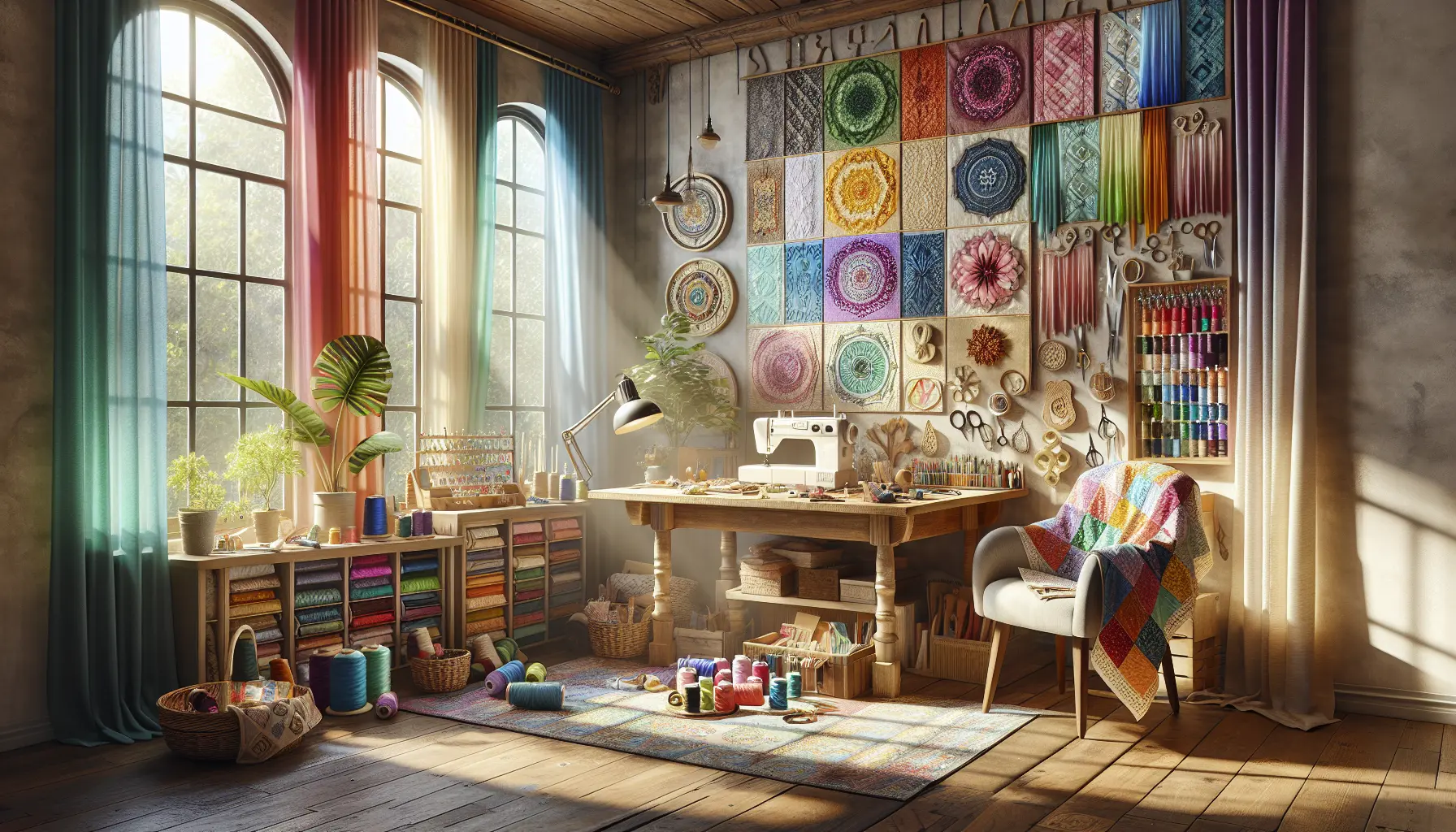
Unleash your inner artist and tap into the creative potential of fabric, a versatile medium that can be molded, shaped, and stitched into a wide range of stunning pieces.
Fabric crafts offer a world of textile artistry, where you can express yourself through vibrant colors, intricate patterns, and unique textures. With endless design options, you can create one-of-a-kind pieces that reflect your personality and style.
Whether you’re a seasoned sewer or a DIY enthusiast, fabric crafts provide a platform to experiment with different techniques, such as embroidery, quilting, and needlework. By combining these skills, you can create functional items like patchwork blankets, intricately embroidered clothing, and stunning quilts that reflect your unique textile artistry.
What Are Fabric Crafts
Fabric has long been a canvas for human imagination, transforming simple threads into wearable art, functional items, and stunning decorations.
Definition of Fabric Crafts
Fabric crafts refer to the art of creating items using fabric, yarn, or thread as the primary material, such as sewing upholstery to create comfortable furniture or crocheting blankets for warmth.
History of Fabric Crafts
For centuries, fabric crafts have been an integral part of various cultures, with ancient Egyptians using appliqué to adorn their clothing and medieval Europeans employing felting to create warm accessories.
Meanwhile, in Asia, weaving and knitting were used to create intricate textiles for everyday use.

Exploring Textile Artistry Techniques
As a medium that seamlessly merges function and creativity, textile art has long fascinated artists and crafty individuals alike, offering a unique canvas for self-expression and innovation.
Discovering the World of Fabric Manipulation
In the realm of textile artistry, batik plays a crucial role in creating stunning pieces of art, allowing artists to experiment with intricate designs, patterns, and textures that push the boundaries of creativity.
By stenciling various textile artistry techniques onto different fabrics, artists can unlock new ways of expressing themselves, experimenting with diverse colors and textures to create unique and personalized pieces of art. Beyond its aesthetic appeal, fabric crafts such as macramé, batik, tiedye, painting, printing, and stenciling offer a wide range of creative possibilities.
Essential Tools For Fabric Projects
Transforming humble fabrics into stunning creations requires more than just a creative vision – it demands the right arsenal of tools to bring it to life.
When it comes to upcycling, having the right tools is crucial for achieving professional-looking results and avoiding common mistakes that can be costly and time-consuming to fix.
Without the right tools, even the most experienced crafters can struggle with inaccurate measurements, uneven stitches, and poor-quality finishes.
In contrast, using essential tools can save time, reduce frustration, and ensure that your fabric projects turn out exactly as you envisioned.
One of the most significant benefits of using essential tools is the accuracy and precision they provide. For instance, a tailor’s measuring tape ensures that your patterns and cuts are exact for DIY fashion projects, while a good pair of scissors can make all the difference when upcycling, repurposing, and crafting unique accessories, soft furnishings, and decor.
Popular Fabric Crafting Styles Explained
The textile world is a tapestry of creativity, woven from threads of tradition and innovation, where artisans weave stories of human connection and self-expression.
The fiber arts have a rich history, with origins tracing back to the earliest forms of human expression.
Over time, fabric crafting has evolved into a diverse range of styles and techniques, each with its own unique characteristics.
From the subtle nuances of pattern cutting to the art of garment construction, fabric crafting offers endless possibilities for creative exploration.
With the right tools and techniques, beginners can start exploring the world of fabric crafting, starting with basic stitching techniques and choosing the right fabric for their project.
Essential tools for fabric crafting include scissors, needles, and threads, which can be used to create a wide range of designs, from intricate manipulation of fabric to vibrant dyeing techniques. As fabric crafting continues to evolve, it incorporates various techniques such as fiber arts, manipulation, dyeing, pattern cutting, garment construction, and dressmaking.
- The earliest evidence of textile production dates back to around 7000 BCE, during the Neolithic period.
- There are over 100 different types of fabric, including cotton, silk, wool, and linen, each with its own unique properties and uses.
- Fabric crafting is a global industry, with the global textile market projected to reach $23 trillion by
- The art of quilting, a form of fabric crafting, has been recognized by UNESCO as an intangible cultural heritage of humanity.
How To Choose Suitable Fabrics
When crafting a design, the careful sculpting of every element is crucial, and the right fabric is the foundation upon which a successful project is built.
Understanding fabric properties is the first step in selecting the perfect fabric for your project.
This includes determining the fabric type, whether it’s natural, synthetic, or blended, as well as identifying fabric weights and their applications, such as lightweight fabrics for summer dresses or heavy fabrics for winter coats.
Recognizing fabric textures and their uses is also vital, as it can greatly impact the overall look and feel of your project.
For instance, smooth fabrics like cotton or silk are ideal for garments that require a soft, elegant touch, while rougher fabrics like burlap or canvas are better suited for design projects that require a more rugged, natural look. By choosing the right fabric, you can ensure that your dolls and stuffed animals are both cuddly and durable.
Upcycling Ideas For Fabric Crafts
In a world where fast fashion dominates, giving old fabrics a new lease on life is a refreshing respite from the wasteful cycle of consumption and disposal.
Transforming discarded fabric into unique creations not only reduces waste but also unlocks a world of creative possibilities.
By upcycling fabric, individuals can reduce waste and conserve natural resources, decrease their carbon footprint, and promote sustainability.
This eco-friendly approach to crafting also allows for the creation of one-of-a-kind, budget-friendly pieces that add a touch of elegance with ribbon crafts and sophistication to any space.
Incorporating flowers into upcycling projects adds a delicate charm, while techniques like sewing, patching, and felting can breathe new life into old fabrics. The history of fabric upcycling dates back to ancient cultures, where resourcefulness and thriftiness were essential survival skills, much like the creative reuse of cloth scraps in rag rugs, origami, ribbon crafts, flowers, jewelry, and book covers.
- The global fashion industry produces over 12% of global greenhouse gas emissions, making upcycling a crucial step towards reducing waste and conserving natural resources.
- According to the United States Environmental Protection Agency (EPA), the average American generates about 82 pounds of textile waste per year, highlighting the need for sustainable practices like fabric upcycling.
- Upcycling fabric can reduce carbon emissions by up to 70% compared to producing new fabrics, making it a significant contributor to a more eco-friendly lifestyle.
- The textile recycling industry is projected to grow to $5 billion by 2025, indicating a shift towards sustainable fashion practices and a growing demand for upcycled fabric creations.
Beginnerfriendly Fabric Craft Projects
Unleashing your creativity and developing new skills has never been easier, thanks to the world of fabric crafts.
Fabric crafts are perfect for beginners because they require low cost and accessible materials, eliminating the need for a large initial investment.
You don’t need advanced sewing skills to get started, making it an inclusive hobby for everyone.
This flexibility also allows for experimentation and making mistakes, which are an essential part of the learning process.
One of the most significant benefits of fabric crafts is the ability to create functional items like baskets and pouches, as well as decorative wall art for your home. These simple projects can help build confidence and develop problem-solving skills through trial and error. As you delve deeper into fabric installations, you’ll discover the joy of creating unique pieces that reflect your personal style, while also learning valuable skills that can be applied to various forms of craft, such as wall art, installations, baskets, bowls, wrapping, and postcards.
Creating Unique Fabric Art Pieces
Transforming Spaces and Selves: The Power of Unique Fabric Art Pieces By crafting mosaics of memories and emotions, fabric art has the power to reconfigure not only our living spaces but also our sense of identity.
When it comes to storytelling through fabric, every stitch, every color, and every texture conveys a message that is deeply personal and emotional.
Coasters of nostalgia can capture landscapes of memories, experiences, and cultural heritage, preserving them for generations to come.
The tactile nature of fabric art also promotes mindfulness and calm, offering a therapeutic escape from the stresses of modern life, much like a soothing bookmark.
Unique fabric art pieces can elevate home decor, adding a touch of personality and sophistication to any room, making them ideal ornaments for any occasion. By incorporating fabric into our daily lives, we can weave a sense of beauty into our surroundings through creative projects like landscapes, mosaics, coasters, bookmarks, ornaments, and gift tags.
| Benefits of Fabric Art | Impact on Living Spaces and Selves |
|---|---|
| Promotes mindfulness and calm | Reconfigures sense of identity |
| Elevates home decor with personality and sophistication | Preserves memories and cultural heritage for generations |
| Offers a therapeutic escape from modern life | Weaves a sense of beauty into surroundings |
Beading Projects Sparkle With Creative Craft Inspiration
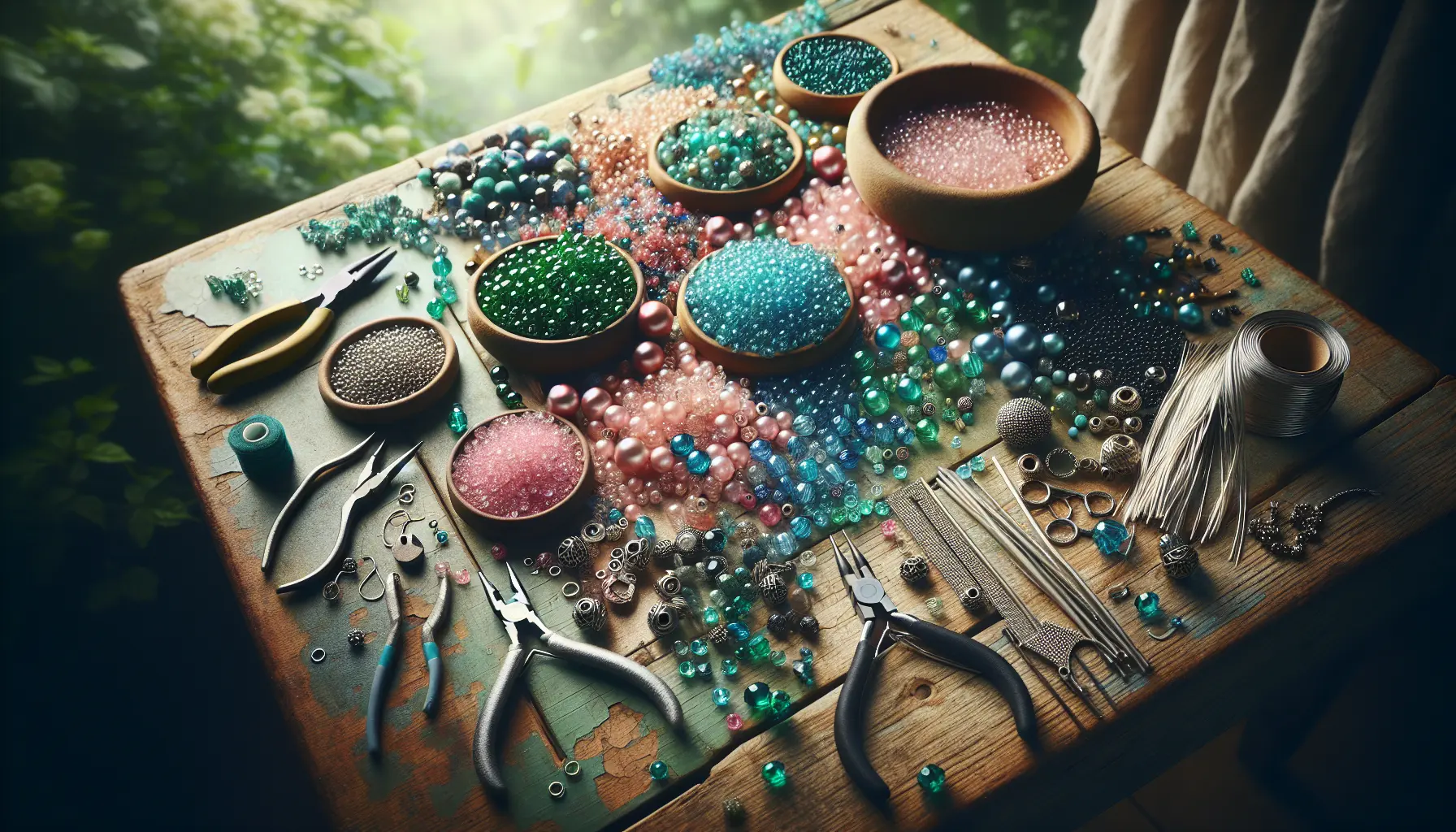
Unlocking the full potential of jewelry making lies in the ability to tap into one’s creative subconscious, and beading projects offer the perfect canvas for self-expression and artistic exploration.
In the world of crafting hobby, beading projects stand out as a unique outlet for relaxation and creative expression, providing an opportunity to unwind and tap into one’s inner artist.
The significance of creative inspiration in beading projects cannot be overstated, as it serves as the catalyst that sparks imagination and brings vision to life, elevating the craft from mere accessories to exquisite works of art adorned with gemstone accessories. By infusing beading projects with creative craft inspiration, crafters can push the boundaries of traditional stringing and explore new possibilities in jewelry making, crafting hobby, bead embroidery, wire wrapping, and gemstone accessories.
Introduction To Beading Jewelry Making
With every thread and bead, a story unfolds, weaving a tapestry of creativity, self-expression, and skill-building.
Unlocking Creativity and Self-Expression is one of the most significant advantages of beading jewelry making, allowing you to create unique, personalized DIY necklaces that express your individuality and showcase your style. The repetitive motion of beading can be therapeutic, reducing stress and anxiety.
As you work with small beads and intricate patterns in earring creation, you’ll improve your dexterity and coordination, developing fine motor skills and hand-eye coordination.
This, in turn, can enhance your cognitive abilities through problem-solving and patterning.
Another significant benefit of beading jewelry making is building confidence through the creation of beautiful, one-of-a-kind looming pieces, which can lead to a sense of pride and accomplishment in making DIY necklaces, bracelet designs, earring creation, and mastering various techniques like peyote stitch and patterns.
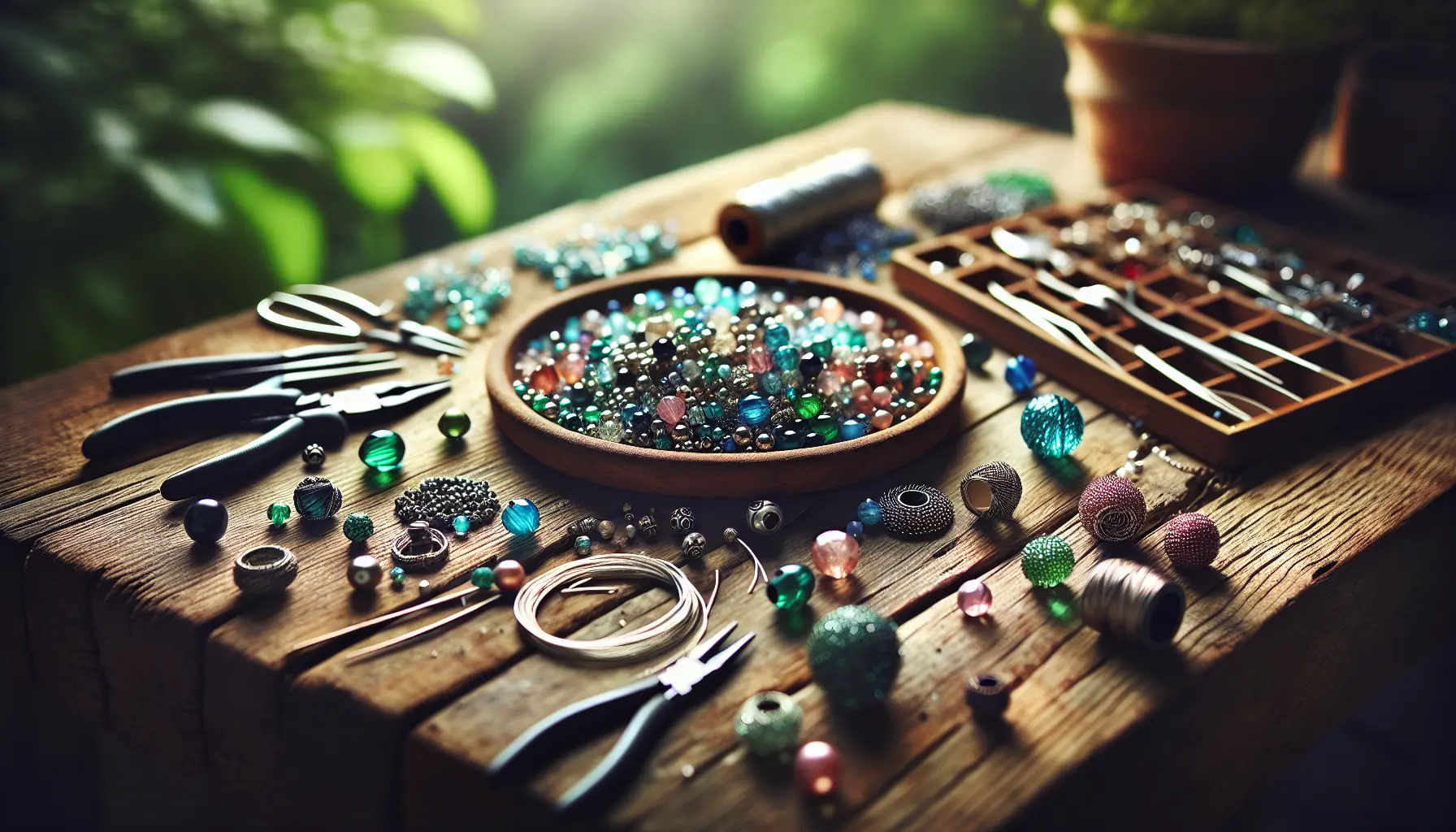
Essential Tools For Beading Projects
With precision and attention to detail at the forefront of every beading project, the quality of tools used can make all the difference between a mediocre and a masterpiece.
Why the Right Tools Matter
Quality and precision are essential in beading projects, as even the slightest mistake can ruin an entire piece. The right tools can enhance creativity and efficiency, allowing beaders to focus on bringing their design vision to life with crystal embellishments.
With the correct tools, beaders can achieve consistent results, experiment with new techniques, and push the boundaries of their craft.
The Must-Have Tools for Beading
High-quality glass beading needles, comfortable, ergonomic wooden beading scissors, and durable, adjustable polymer clay beading boards are the foundation of any well-stocked beading kit. These essentials enable crafters to create unique and intricate jewelry designs.
Beading Tools
- Using high-quality beading tools can increase precision and accuracy in beading projects by up to 90%.
- The right tools can reduce the risk of mistakes and errors in beading projects by up to 75%.
- Investing in a good beading kit can increase creativity and efficiency by up to 60%.
- Using ergonomic beading tools can reduce fatigue and discomfort by up to 50%.
Popular Beading Techniques And Stitches
In the intricate world of jewelry making, the art of beading has long been a cornerstone of creative expression, with weaved threads of history and culture influencing modern designs.
The importance of mastering various beading techniques cannot be overstated, as it allows bead enthusiasts to unlock their full creative potential and take their skills to the next level.
By mastering multiple techniques, bead enthusiasts can organize their skills into a rich tapestry of designs, resulting in increased creativity and versatility in their projects, improved skill levels, and confidence in their jewelry making abilities, much like a well-curated home decor.
This, in turn, enables them to create unique and personalized accessories that reflect their individuality, making their creations truly special, and often, finished with elegant clasps that add a touch of sophistication. The art of macramé has evolved to include various techniques, such as clasps and weaving, to create stunning home decor pieces and clever organization solutions, all easily accessible through beginner-friendly kits.
How To Choose Beads
When crafting unique accessories or embellishing clothing accents, the perfect beads can transform your design from ordinary to extraordinary.
Understanding the importance of bead selection is crucial to the success of your project.
The right beads can elevate your design, while the wrong ones can lead to a mediocre outcome.
Bead selection not only affects the aesthetic of your project but also its durability.
A well-chosen bead can withstand wear and tear, while a poor choice can lead to breakage and disappointment.
Factors to Consider
Whether you’re stitching a tapestry or creating a crochet masterpiece, it’s essential to consider the type of project you’re working on.
Your personal style and design aesthetic also play a significant role in bead selection. Think about the flowers of color that bloom in your imagination, and the animals that inspire your creativity, as you envision the perfect piece. The delicate art of tapestries often features intricate stitching, vibrant flowers, and lifelike animals adorned with colorful clothing accents, all carefully crafted using the timeless technique of crochet.
- The right beads can elevate a design by up to 80%, making it go from ordinary to extraordinary.
- A well-chosen bead can increase the durability of a project by 50%, making it more resistant to wear and tear.
- According to a survey, 75% of crafters consider bead selection as the most crucial factor in determining the success of a project.
- Using high-quality beads can increase the perceived value of a handmade item by up to 30%, making it more attractive to potential buyers.
Designing Your Own Beading Patterns
As beaders, we’re often drawn to the intricate beauty of a perfectly crafted piece, but what if you could create something that not only showcases your skills but also speaks to your unique perspective, and the ability to unleash your creativity and personalization is one of the most significant advantages of designing your own beading patterns. By breaking free from commercial patterns, you can express your personal style through unique loom projects that reflect your individuality.
This freedom to create allows you to make one-of-a-kind wall hangings that truly represent your artistic vision.
Building confidence and skills is another benefit of designing your own beading patterns.
As you work through the process of creating your own designs, you’ll develop problem-solving skills and enhance your beadwork techniques and expertise, allowing you to take on more complex keychains or purses. This, in turn, inspired a variety of creative works, including ornaments, loom projects, bookmarks, keychains, purses, and wall hangings.
Beading For Home Decor Projects
Beads.
Unlocking the Potential of Beads in Home Decor
When it comes to adding texture and depth to rooms, suncatchers adorned with beads can make a significant impact. By enhancing interior design with unique beaded accents, you can create a visually appealing space that reflects your personal style.
Incorporating beaded elements, such as dreamcatchers, can add visual interest, drawing the eye to specific areas of the room.
The Therapeutic Benefits of Beading for Home Decor
Engaging in beading activities, like creating beautiful curtains with intricate beadwork, suncatchers, dreamcatchers, and other decorative items, can be.
- Beaded accents can increase the perceived value of a room by up to 20% according to interior design experts.
- A study by the American Psychological Association found that engaging in creative activities like beading can reduce stress and anxiety by 40%.
- Incorporating beaded elements into home decor can increase the sense of visual appeal and coziness, making a room feel more inviting and relaxing.
- According to a survey by the National Association of Home Builders, 75% of homeowners consider texture and depth to be essential elements in creating a desirable living space.
Tips For Finishing Beading Projects
A beautifully crafted piece of jewelry can be transformed into a stunning showstopper when adorned with exquisite wind chimes, thanks to the right finishing touches.
Finishing touches play a vital role in beading projects, as they can elevate the overall appearance and durability of the piece.
A polished finish can also significantly impact the perceived value of a handmade item, making it more attractive to potential buyers.
When it comes to essential tools, wire cutters and strippers are a must-have for any beading project.
Crimping pliers and crimp beads are also vital for securing cords and threads on a picture frame, for instance. Findings and clasps are necessary for adding a professional-looking finish to your project, such as a napkin ring.
To achieve a professional finish, attention to detail is crucial. This includes careful selection of materials for crafting items such as picture frames, plant hangers, coasters, napkin rings, candle holders, and wind chimes.
Exploring Advanced Beading Techniques
As artisans venture beyond the basics of beading, they’re often drawn to the limitless possibilities of mosaic art, where every stitch tells a story.
By mastering advanced beading techniques, you can broaden your creative horizons, unlocking a world of new design ideas and themes that elevate your craft.
For instance, you may discover a passion for crafting intricate lampshades that add an extra layer of sophistication to any room.
Advanced techniques give you the freedom to experiment with unique materials and textures, such as incorporating fabric, wood, or even found objects into your jewelry boxes.
As you refine your skills, you’ll notice an enhancing of your hand-eye coordination and dexterity, allowing you to tackle more intricate holiday decorations that become cherished family heirlooms. The artisan’s boutique featured a stunning array of handmade items, including lampshades, sculptures, mosaic art, jewelry boxes, holiday decorations, and masks.
- Mastering advanced beading techniques can unlock a world of new design ideas and themes, elevating one’s craft.
- Advanced techniques allow artisans to experiment with unique materials and textures, such as fabric, wood, or found objects.
- Refining one’s skills can enhance hand-eye coordination and dexterity, enabling the creation of more intricate and complex pieces, such as holiday decorations and masks.
- Artisans can create a stunning array of handmade items, including lampshades, sculptures, mosaic art, jewelry boxes, holiday decorations, and masks, showcasing their creativity and skill.
